Yachting Monthly
- Digital edition

Boat maintenance: the 55-point skipper’s checklist
- Katy Stickland
- April 27, 2021
The ultimate boat maintenance checklist to make sure your yacht is ready for launch and the start of the sailing season

Check your rudder for hairline cracks or damage

Boat maintenance: Mast & Rigging

Check all your standing rigging connections. Credit: Colin Work
- The mast cap is out of sight, out of mind 99% of the time, but serves multiple functions: backstay, forestay, cap shrouds, radio antenna, nav lights, halyard sheaves. Rotate mast and boom sheaves to check they are not misaligned or worn by a bad halyard lead. Lubricate sheaves with WD40 or silicone grease.
- Spreaders, gooseneck, mast heel, kicker, mainsheet and topping lift connections all need checking for wear, damage or corrosion.
- Check for galvanic corrosion between different metals.
- Check electrical connections, deck and spreader lights.
- Wax mast tracks and luff grooves with candle wax or Teflon spray.
- Standing rigging: Look for areas of wear or stranding on the wire. Check mast tangs, T-ball joints and rigging screws.
- Wash furling drum and swivel and check they move freely. It’s common for the top swivels to become stiff and sometimes seize, which can compromise the forestay wire.
- Running rigging: check for chafe and that the shackles aren’t seized. Sheets, halyards, warps: wash in fresh water to get rid of salt and grime.
- Deck winches : strip down, wash parts in paraffin, wash off with soapy water and lightly regrease .
- Windlass : if manual, check it’s working, clean and tighten. For powered versions check foot switch for water, clean and use Vaseline on the connections.
- Anchor chain : Re-mark lengths if faded, or add chain markers. Check for condition and wear.
Head, bilge & gas

Check bilge pumps it might sound ok but is it actually attached to a hose?
- Check impeller on bilge pumps and grease with water pump grease only (Vaseline will rot impellers)
- If you have an automatic bilge pump, check float switches work.
- Dry bilges thoroughly then if water appears after relaunch you’ll know you’ve got a leak.
- Fill water tank and add purifier such as Puriclean or Milton
- If the pump on the heads is stiff look to service and lubricate with silicon grease.
- If you have a gas sensor, check it works.
Boat maintenance: Below waterline
Hull and skin fittings.

Check jubilee clips for rust. Credit: Bob Aylott
- Most vessels have DZR (dezincification-resistant brass) seacocks. Look for any signs of corrosion on the skin and tail joints, which are common points of failure.
- Ensure all valves are greased.
- All hoses should be double-clipped. Check jubilee clips for rust . Do you have wooden plugs attached in case of emergency?
- Check skin fittings are free of blockages/ growth or antifouling.
- Check anodes have plenty of life . Don’t forget prop shaft and saildrive anodes.
- Check leading, trailing and lower sections for damage or hairline cracks.
- Check for play in bearings, stock or quadrant. Movement should be minimal. Grease steering cable.
- Check for stress cracks or movement internally and externally – especially at the keel root and around the internal framing or matrix, and around fastenings and backing washers.
Prop shaft & stern gland
- To check bearings, grasp prop in both hands and try moving it up and down and from side to side. There should be little, if any, movement – no more than 2mm.
- Check P-bracket for stress cracking from misalignment or damage.
- Stern gland packing. Many yachts have some form of deep-seal arrangement that has a service life of around seven years. Those that have a proper stuffing gland will need to be greased to prevent drying out and getting brittle. The gland may need pulling down or repacking at some point.
- If you have a saildrive, check the condition of the seal and the metal ring that holds it in position. Again, note the seals have a life expectancy of between five and seven years depending on manufacture.
Boat maintenance: Mechanics
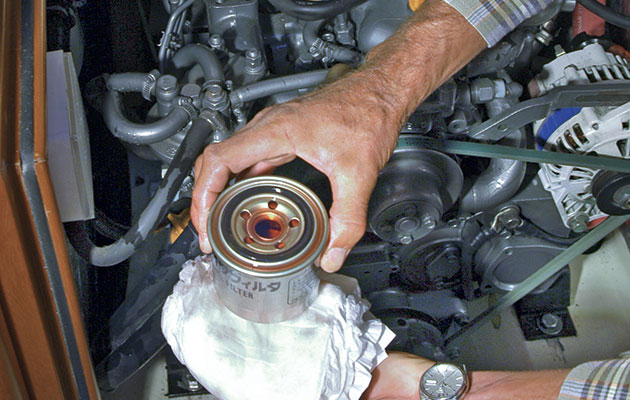
Check all filters
- If you didn’t change the oil when you laid up, change it now.
- Change fuel filters.
- Remove rags stuffed in outlet pipes from winterisation.
- Impellers – if removed at lay-up – reinstall with a smear of water pump grease.
- Reinstall the engine belts and check tension: there should be no more than half an inch of play.
- Check oil levels. Check durability of the gaiter seal. Check rubber faring and reseal if necessary.
- Change internal engine anode.
- Check engine mount is secure.
- Check diesel tank for water from condensation . Drain off or replace fuel. Add an appropriate biocide to help kill off diesel bug .
- Check inaccessible wiring, such as bonding wires from the anode and earthing wires from the starter motor. Clean the terminals and smear them with Vaseline or silicone gel.
Batteries and electrical systems
- Check electrolyte level if yours is an open lead acid battery; tighten battery securing straps and make sure vent for gases is clear. Clean terminals and coat with Vaseline. For sealed batteries, check the condition of indicator light, or other charge indicator.
- Switch on instruments and use backlighting to help reduce any condensation.
- If the anode looks serviceable for another season, check bonding and wires. If they haven’t worn at all they may not be working so check Ohm resistance max 0.2 from propeller to anode.
- Check for chafe, wayward stitching and tears. Do you carry a sail repair kit?
- Take to a sailmaker if the sacrificial strips is worn out.

Make sure your navigation apps are up to date
- Update charts from Notice to Mariners .
- For electronic charts, check with your supplier how to update. New chartplotters can connect to WiFi, or you may need to connect the chart chip to your PC at home and download the update.
- Download operating software updates for your chartplotter and instruments.
- Make sure your subscriptions for navigation apps on phone and tablets are up to date with the latest charts.
- Check age of hoses. If they are over five years old, they should be replaced. Check for kinking or wear in gas hosepipes. If in doubt, replace.
- Check hose clips are tight. Hoses behind cookers should be armoured.
- Check thermal cut outs on hob, grill and oven work.
Harness/lifelines
- Check stitching and get repairs done by a sailmaker if necessary.
- Jackstay and Danbuoy lines: check condition and points of security.
- If you have the traditional type, check the bulb, battery and that it actually works. The new types have various ways of testing, and all have an expiry date.
Lifejackets

Is your lifejacket fit for purpose and in good condition? Credit: Theo Stocker
- Inflate using mouth tube. Leave inflated overnight to check for leaks .
- Wash with fresh water
- Weigh cylinder and check lights if fitted.
Stanchions/lifelines
- Check stanchions and make sure lifelines are still suitably secured at each end and cords and pins are in good order.
- Watch out for wire failing if you have plastic sheathing.
- Make sure these are in date, in a watertight container and are easy to reach. It’s worth having gloves and goggles to hand too.
- Make sure these are in date and registered with the correct contact details.
- Ensure this and the hydrostastic release are within the service date, and you are aware of its contents .
- If its secured with a rope, consider if you could release it in an emergency with ease.
- Make a grab bag up with essentials
Enjoyed reading Boat maintenance: the 55-point skipper’s checklist?
A subscription to Yachting Monthly magazine costs around 40% less than the cover price .
Print and digital editions are available through Magazines Direct – where you can also find the latest deals .
YM is packed with information to help you get the most from your time on the water.
- Take your seamanship to the next level with tips, advice and skills from our experts
- Impartial in-depth reviews of the latest yachts and equipment
- Cruising guides to help you reach those dream destinations
Follow us on Facebook , Twitter and Instagram.
ACTIVE STORM TRACKER Hurricane and Tropical Storm Information Learn more

Service Locator
- Angler Endorsement
- Boat Towing Coverage
- Mechanical Breakdown
- Insurance Requirements in Mexico
- Agreed Hull Value
- Actual Cash Value
- Liability Only
- Insurance Payment Options
- Claims Information
- Towing Service Agreement
- Membership Plans
- Boat Show Tickets
- BoatUS Boats For Sale
- Membership Payment Options
- Consumer Affairs
- Boat Documentation Requirements
- Installation Instructions
- Shipping & Handling Information
- Contact Boat Lettering
- End User Agreement
- Frequently Asked Questions
- Vessel Documentation
- BoatUS Foundation
- Government Affairs
- Powercruisers
- Buying & Selling Advice
- Maintenance
- Tow Vehicles
- Make & Create
- Makeovers & Refitting
- Accessories
- Electronics
- Skills, Tips, Tools
- Spring Preparation
- Winterization
- Boaters’ Rights
- Environment & Clean Water
- Boat Safety
- Navigational Hazards
- Personal Safety
- Batteries & Onboard Power
- Motors, Engines, Propulsion
- Books & Movies
- Cockpit Confessions
- Communication & Etiquette
- Contests & Sweepstakes
- Colleges & Tech Schools
- Food, Drink, Entertainment
- New To Boating
- Travel & Destinations
- Watersports
- Anchors & Anchoring
- Boat Handling
- ← How-To DIY
Boat And Trailer Maintenance Checklist
Advertisement
Take care of the boat, trailer, and engine and the chances of a problem occurring on the water or the road will be minimized. Here's what you need to know.
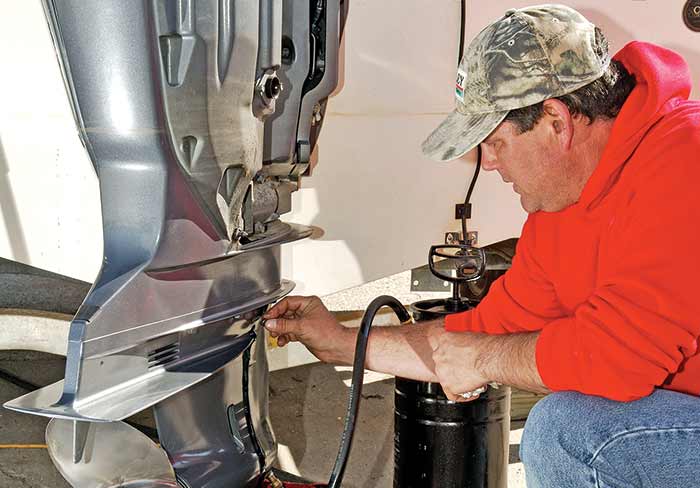
Whether you do it yourself or leave it to the pros, routine maintenance is essential to keep your rig in tip-top shape.
So you're a new boat owner. Your pristine center-console sits proudly in your driveway, the outboard shining brightly in the sun, and even the trailer is sleek and polished. How can you keep it at least close to looking and performing as it does now? Maintenance is the key.
But if you're not mechanically inclined, how can you properly care for your new rig? If you're all thumbs, budget in some bucks for dealer maintenance. In this case, it's probably best for both you and your boat if you leave the mechanical details to the pros. You can, however, perform all the tasks that don't require technical expertise. Such tasks as keeping fittings and moving parts lubricated, cleaning and waxing the finish, checking the drive lubricant and engine oil, making sure that fishing line isn't wrapped around the prop shaft — these are all examples of simple skills a responsible boater should learn, especially to protect his or her investment. While boats have never been cheap, they seem to be more expensive than ever when compared to the average paycheck, so it's smart ownership to make sure that all is up to snuff.
To help you out, we've created a simple Timeline and Maintenance Chart, one that works for DIYers and tech-savvy boaters alike. Refer to the chart to check maintenance items before every outing and at every 20, 50, and 100 hours of use. Seasonal boaters should consult the chart before every layup. With our chart as your guide, your rig will stay like new for longer and command top price at resale or trade-in time, particularly if you keep records of what you've done and when. The chart is the suggested schedule, although some boats may require more frequent checks. If in doubt always follow the manufacturer's recommendations for your particular boat, engine, and trailer.
Click on checkmarks in the chart below to watch our how-to videos.
| Always follow recommendations in manual first | Every Outing | Every 20 hrs. | Every 50 hrs. | Every 100 hrs. | Before Layup | Video |
|---|---|---|---|---|---|---|
| Check oil/fill | ||||||
| Check transom mounting bolts/jack plate bolts (if equipped) | ||||||
| Check propeller and skeg for damage | ||||||
| Check cowl air intakes for blockages | ||||||
| Check engine operating temperature | ||||||
| Check oil pressure | ||||||
| Check drive/gearcase for water/particulate/burnt lubricant & refill | ||||||
| Check engine for proper operating RPM @ WOT | ||||||
| Check fuel lines for alcohol and UV degradation | ||||||
| Replace fuel/water separating filter | ||||||
| Check power trim/tilt fluid, refill if necessary | ||||||
| Check engine mounts and swivel/steering bracket for excessive play | ||||||
| Lubricate all grease points | ||||||
| Coat electrical w/silicone protectant spray | ||||||
| Have linkage/synchronization checked | ||||||
| Retorque all accessible bolts/fasteners | ||||||
| Touch up paint | ||||||
| Check spark plugs and replace as necessary | ||||||
| Change and check condition of gearcase lube and powerhead oil | ||||||
| Replace water-pump impeller | ||||||
| Treat fuel with storage conditioner, fog engine, drain/refill oil, replace oil/fuel filters | ||||||
| Check for excessive play/movement | ||||||
| Check fluid level/check for leaks/bleed system (hydraulic) | ||||||
| Check engine free-play and adjust | ||||||
| Lubricate all grease points | ||||||
| Check for kinks (hydraulic and mechanical) and/or binding (mechanical) | ||||||
| Check hull for damage; repair if necessary | ✔ | ✔ | ✔ | |||
| Wash hull and deck | ✔ | ✔ | ✔ | |||
| Check registration and inspection to ensure they're up-to-date | ✔ | ✔ | ✔ | |||
| Check bilge pump and auto switch for proper operation | ✔ | ✔ | ✔ | |||
| Check battery(s) for proper charge | ✔ | ✔ | ✔ | |||
| Check all other electrical accessories and systems for proper operation | ✔ | ✔ | ✔ | |||
| Check safety gear to ensure it is up-to-date and in good condition | ✔ | ✔ | ✔ | |||
| Check fire extinguishing systems | ✔ | ✔ | ✔ | |||
| Clean and protect interior | ✔ | ✔ | ✔ | |||
| Clean bilge | ✔ | ✔ | ✔ | |||
| Wax/polish hull and deck | ✔ | ✔ | ||||
| Check top, cover, etc., for condition, proper storage, and clean/protect | ✔ | ✔ | ||||
| Check bow and stern eyes for tightness and secure mounting | ✔ | ✔ | ||||
| Check rubrail for damage and repair if necessary | ✔ | ✔ | ||||
| Check all cleats, rail fittings, and deck fittings for tightness and secure mounting | ✔ | ✔ | ||||
| Check coupler mechanism for proper operation, lubricate w/silicone spray | ✔ | ✔ | ✔ | ✔ | ||
| Check safety chains for rust, damage | ✔ | ✔ | ✔ | ✔ | ||
| Check winch and winch strap; check emergency retention chain/strap | ✔ | ✔ | ✔ | ✔ | ||
| Check tiedowns and tiedown eyes | ✔ | ✔ | ✔ | ✔ | ||
| Check lights, connector, and wiring harness and repair if necessary | ✔ | ✔ | ✔ | ✔ | ||
| Check tires for proper inflation pressure (including spare), check brakes | ✔ | ✔ | ✔ | ✔ | ||
| Check wheel bearings for proper grease level, binding, excessive noise | ✔ | ✔ | ✔ | ✔ | ||
| Check suspension for rust, damage, missing bolts; repair if necessary | ✔ | ✔ | ✔ | |||
| Check tires for age, weather checking, low/uneven tread (including spare) | ✔ | ✔ | ✔ | ✔ | ||
| Check wheel condition for rust, cracks, or bends | ✔ | ✔ | ✔ | |||
| Check boat support bunks and rollers | ✔ | ✔ | ✔ | ✔ | ||
| Check frame for rust, paint if necessary | ✔ | ✔ | ||||
| Check wheel bearings and seals, repack with grease | ✔ | ✔ | ||||
Download a copy of the checklist above.
Related Articles
The truth about ceramic coatings for boats.
Our editor investigates the marketing claims of consumer-grade ceramic coatings.
Fine-Tune Your Side Scan Fishfinder
Take your side-scanning fishfinder off auto mode, and you’ll be spotting your prey from afar in no time
DIY Boat Foam Decking
Closed-cell foam flooring helps make boating more comfortable. Here’s how to install it on your vessel
Click to explore related articles
Contributor, BoatUS Magazine
John Tiger is a freelance boating writer and frequent contributor to many magazines.
BoatUS Magazine Is A Benefit Of BoatUS Membership
Membership Benefits Include:
Subscription to the print version of BoatUS Magazine
4% back on purchases from West Marine stores or online at WestMarine.com
Discounts on fuel, transient slips, repairs and more at over 1,200 businesses
Deals on cruises, charters, car rentals, hotel stays and more…
All for only $25/year!
We use cookies to enhance your visit to our website and to improve your experience. By continuing to use our website, you’re agreeing to our cookie policy.
- Sales: (954) 833-0125
- Service: (954) 466-0121

ONEWATER YACHT GROUP BLOG
Yacht maintenance overview: how to properly care for your yacht.
- June 7, 2021

YACHT MAINTENANCE SCHEDULE
Additional yacht maintenance tips.

YACHT MAINTENANCE RESOURCES & ADDITIONAL INFORMATION
- MTU Diesel Engines have an extraordinary history extending as far back as 1900. MTU is now a subsidiary of Rolls Royce Power Systems. The MTU Series 4000 Diesel has accumulated over 180,000,000 hours of operation. Their engines are developed for a world of large commercial and passenger ships.
- Caterpillar Marine Power Systems . Caterpillar Marine has the most comprehensive range of engine types in the world. CAT engines fall into several divisions including Cruisers, Fishing and Pleasure Craft. Worldwide dealer support is a powerful asset when considering engine types.
- MAN Yacht Engines . The story of MAN Engines can be charted back to 1758 when St. Antony Ironworks began operation in Oberhausen Germany. Owners of a MAN Yacht Engine must sign off on approval of their merchandise, and that is just the introduction of their superb protection.
- Cummins Marine . Worldwide support is a necessary factor when choosing your power plant. Cummins Marine is another recognizable brand that has been building marine engines since 1919. The Cummins Service Network is one of the widest in the world and extremely robust.
- Volvo Penta Marine Leisure . Volvo Penta has carved out a vast swath of the marine propulsion industry. While other engine builders cater to the superyacht niche, Volvo Penta delivers marine systems for yachts in the 60 to 120-foot range. The company has built up a strong group of stern-drive engines for powerboats and a series of engines for sailboats.
- Mercury Marine . Mercury is a well-known brand, and the Mercruiser line of engines are favorites on boats in the 40-foot range or less. Mercury carries a worldwide dealer network. This is a significant advantage when deciding on power. The company offers an extensive line of sterndrive and inboards. The Mercury Diesel is making inroads into larger boats and yachts.
Fuel & Lubrication
Exhaust and air intake, cylinder heads and blocks, electrical systems, transmissions, yacht maintenance costs, one world yacht group service & maintenance, share this article, related articles, discover more at onewater yacht group..

New 2024 Sunseeker 76 Yacht Sold by OneWater Yacht Group
A 76’ Sunseeker yacht built in 2024 was sold by Bryan Braley from OneWater Yacht Group Fort Lauderdale, who represented the dealer. Kerry Iler of

Sunseeker Proudly Unveils the Ocean 156
Sunseeker International, a global leader in luxury yacht design and manufacturing, proudly announces the unveiling of its latest masterpiece, the Ocean 156. The shipyard reveal

85’ Ocean Alexander 2017 Sold by Tom George (SEA NOTE)
SEA NOTE, an 85’ Ocean Alexander motor yacht built in 2017, was sold by OneWater Yacht Group in St. Petersburg, Florida. Yacht broker Tom George
- Chris-Craft
- Our Inventory
- Global Yacht Search
- Find A Broker
- Service Request
- Sell My Yacht
- Ft. Lauderdale, FL
- Palm Beach, FL
- Annapolis, MD
- New York, NY
- Tampa Bay, FL
- Wilmington, NC
- Dania Beach, FL
DISCLAIMER We strive to ensure all pricing and information contained in this website is accurate. Despite our efforts, occasionally errors resulting from typos, inaccurate detail information or technical mistakes may occur. We are not responsible for any such errors and reserve the right to correct them at any time.
This site is protected by reCAPTCHA and the Google Privacy Policy and Terms of Service Apply.
We improve our products and advertising by using Microsoft Clarity to see how you use our website. By using our site, you agree that we and Microsoft can collect and use this data. Our privacy statement has more details.
- Privacy Policy
- Terms Of Use
- Cookie Policy
- Accessibility Statement
- Acceptable Use Policy
- Do Not Sell My Info
Copyright © 2024 OneWater Yacht Group. All Rights Reserved. Powered by Revver Digital
All Right Reserved. Designed and Developed by PenciDesign
Unlocking Success: Your Comprehensive Guide to Boat Maintenance Checklists

Key Takeaways
- Boat maintenance is vital for longevity, safety, and performance.
- Regular upkeep prevents costly repairs and enhances on-water safety.
- Proper maintenance lowers accident risks, improving overall performance.
- A scheduled maintenance plan is crucial for organization and thorough care.
Imagine you’re out on the open water, the wind in your hair and the sun warming your face. But wait, what’s that sound? Is it the engine sputtering? Don’t let a preventable maintenance issue ruin your boating experience. That’s where boat maintenance checklists come in. These handy tools can help you stay on top of essential tasks to keep your vessel in tip-top shape. From inspecting the hull to testing the electrical systems, a well-maintained boat is not only safer but also more reliable. So, let’s dive into the world of boat maintenance checklists and discover how they can help you enjoy worry-free days on the water.
Why Boat Maintenance Matters
Essential boat maintenance tasks, creating a boat maintenance schedule, monthly boat maintenance checklists, annual boat maintenance checklist, tips for effective boat maintenance, common boat maintenance mistakes to avoid, does ultrasonic antifouling work for boats, final thought.
Consistently following boat maintenance checklists is essential to ensure the longevity, safety, and optimal performance of your vessel and its components. Neglecting these routine checks can result in costly repairs and jeopardize your safety on the water. Consistent adherence to boat maintenance checklists helps prevent potential problems, keeping your boat in top shape.

One of the main reasons why boat maintenance matters is that it extends the lifespan of your boat and its components. Just like any other machine, boats experience wear and tear over time. Regular maintenance helps identify and address any issues before they become bigger problems, ensuring your boat lasts for many years to come.
Ensuring water safety is crucial, with 8% of boating accidents and 4% of deaths linked to poor maintenance. Following a maintenance checklist reduces risks. Routine upkeep not only enhances safety but also optimizes boat performance. Regular checks on the engine, hull, and lubrication contribute to efficient and enjoyable water experiences.
Ensure your boat’s safety and performance by using rigging inspection checklist . Regular inspections guarantee that the rigging components are in optimal condition, providing peace of mind during your maritime journeys.
To ensure the longevity, safety, and optimal performance of your vessel, it’s crucial to prioritize essential boat maintenance tasks. Following a boat maintenance schedule is key to keeping your boat in top shape. One of the most important tasks is changing and replacing the engine oil every 50-100 hours of operation. This ensures that your engine performs at its best and reduces the risk of damage. Owners should also regularly check hoses for wear and tear, as well as ensure that fuel levels are adequate to prevent potential failures while on the water.
Another essential maintenance item is auditing the electrical system. Regularly inspecting and cleaning or replacing fuel and air filters is also important to maintain engine performance. Don’t forget to review the boat’s plumbing and HVAC systems, inspect upholstery and canvas, and test ropes, chains, anchors, and docking gear. These tasks will prevent deterioration and ensure safety.
Prioritize the sailboat annual maintenance checklist . Regularly inspect sails before each use and conduct a thorough rig check at least once per season. This ensures safe and efficient sailing, providing peace of mind for enjoyable water time with a well-maintained boat.
When creating a boat maintenance schedule, it is important to establish a well-structured plan that includes regular tasks to ensure your vessel remains in optimal condition. Boat owners should consider the manufacturer’s recommendations as a starting point for creating their schedule. These recommendations will provide guidance on the specific maintenance tasks that should be performed and the frequency at which they should be completed.

Maintaining steerage on a personal watercraft necessitates a comprehensive schedule covering various intervals, such as daily, monthly, and annually. Daily tasks involve checking engine oil and coolant levels, inspecting the bilge for water accumulation, and cleaning the deck. Monthly responsibilities include inspecting the hull and propeller for damage, testing the battery, and lubricating moving parts. Annual maintenance encompasses servicing electrical systems, changing the engine oil and filter, and checking the fuel system for any leaks.
To effectively manage your boat maintenance checklists, it is essential to keep a detailed record of the tasks performed and schedule follow-ups accordingly. This will help you stay organized and ensure that no maintenance tasks are overlooked. Regularly reviewing and updating your schedule will allow you to adapt to changing conditions and prevent any potential issues from escalating.
To effectively maintain your boat on a monthly basis, it is important to complete a series of essential tasks that will ensure its proper functioning and longevity. Here is a monthly boat maintenance checklist to help you keep your vessel in top condition:
- Wash the exterior: Regularly washing the boat’s exterior will prevent dirt, salt, and grime from damaging the paint or gelcoat. Use a mild soap and soft brush to clean the surface thoroughly.
- Check bilges: Inspect the bilges for any signs of water accumulation or oil leaks. Ensure that the bilge pumps are working correctly and remove any debris or obstructions.
- Run engines regularly: Start the engines and let them run for a few minutes to prevent fuel from becoming stale. This will also help identify any potential issues early on.
Regularly follow the boat maintenance checklists on a monthly basis to uphold your boat’s condition and avert potential issues. Refer to your boat’s owner manual for specific maintenance instructions and adhere to safety guidelines. Dedicate time each month to ensure your vessel stays in top shape, ready for your next water adventure.
Performing annual boat maintenance is crucial for ensuring the longevity and optimal performance of your vessel. To keep your boat in top shape, it is important to follow an annual boat maintenance checklist. One essential task is winterizing your boat, especially if you live in an area with cold temperatures. This involves draining and flushing the engine, adding antifreeze to the cooling system, and protecting the plumbing system from freezing.
Another crucial aspect of annual maintenance is checking and maintaining your boat batteries. This includes cleaning the battery terminals, checking the electrolyte levels, and ensuring proper charging. It is also essential to inspect and test all electrical systems on your boat. This includes checking the wiring, connections, lights, and electronics. Address any issues promptly to avoid any electrical failures while out on the water.

As an integral aspect of your boat maintenance routine, it is crucial to annually examine and address waste treatment systems. This includes cleaning holding tanks, inspecting hoses and connections, and ensuring proper functioning of pumps and valves. Addressing deep gouges in the fiberglass of your boat is essential to maintaining its structural integrity.
To effectively maintain your boat and ensure its optimal performance and longevity, it is important to follow these practical tips and expert insights:
- Regularly inspect and clean your boat : Consistent inspections allow you to identify and address any potential issues before they become major problems. Cleaning your boat helps prevent the build-up of dirt, algae, and other contaminants that can damage the hull and affect performance.
- Perform routine maintenance tasks : This includes lubricating fittings, checking fluid levels, and inspecting belts and hoses. By doing these tasks yourself, you can save money and contribute to the overall upkeep of your boat.
- Follow a maintenance schedule : Create a maintenance chart and keep records of all your maintenance activities. This not only helps you stay organized but also increases the resale value of your boat.
One common error to avoid when maintaining your boat is neglecting to regularly check and replace engine oil and filters, which can lead to engine damage and costly repairs. Engine oil plays a crucial role in lubricating the engine’s moving parts and preventing friction and overheating. Over time, oil can become contaminated with dirt, debris, and other impurities, reducing its effectiveness. By not regularly checking and replacing the oil and filters, you risk compromising the engine’s performance and longevity. Integrating this task into your boat maintenance checklist is essential to ensure that your engine continues to run smoothly.
Another mistake to avoid is neglecting to inspect and maintain the boat’s electrical system. Electrical failures can be frustrating and even dangerous while out on the water. Regularly checking the wiring, connections, and batteries can help prevent unexpected power outages and potential safety hazards. Overlooking propeller and propshaft maintenance can have detrimental effects on your boat’s performance. Accumulated fishing line or other debris can cause decreased efficiency and potentially damage the propeller. Including a thorough inspection of the propeller and propshaft in your boat maintenance checklist will help you identify and address any issues promptly.
Include battery checks in your boat maintenance checklists. Regularly inspect charge levels and connections to ensure proper functioning. Neglecting this may lead to unexpected power failures on the water, compromising safety. Make it a routine to avoid inconveniences.
Ultrasonic antifouling is a technology designed to prevent the growth of marine organisms, such as barnacles and algae, on the hulls of boats. The system typically involves the installation of ultrasonic transducers on the boat’s hull. These transducers emit high-frequency sound waves that create vibrations on the hull surface, disrupting the settlement of marine organisms.
The effectiveness of ultrasonic antifouling systems can vary, and opinions on their success are mixed. Some boat owners claim positive results, citing reduced fouling and the need for less traditional antifouling paint. However, there is ongoing debate within the boating community about the overall efficacy of this technology.
It’s important for boat owners to consider factors such as the specific conditions in which the boat operates, the type of marine life in the area, and the particular ultrasonic system used. While some users report success, others may find that traditional antifouling methods remain more reliable for keeping boat hulls free from marine growth.
Boat maintenance checklists are the secret to a smooth sailing experience! By following these simple yet crucial tasks, you can keep your vessel in top shape, prevent any unexpected issues, and ensure a safe and enjoyable time on the water. Don’t underestimate the power of regular maintenance – it’s the key to extending the lifespan of your boat and ensuring its peak performance. So, grab that checklist and get ready to cruise with confidence!
Further Readings
https://www.epa.gov/nps/nonpoint-source-marinas-and-boating https://www.uti.edu/blog/marine/boat-engine-types
David Seibert
"Meet David Seibert, a passionate advocate for all things nautical and the driving force behind Boat Hire Hub. Dedicated to curating exceptional boating experiences, David and the Boat Hire Hub team are committed to making every journey on the water unforgettable. Join us as we navigate the seas of adventure, creating memories one wave at a time. ⚓🌊 #BoatHireHub #SeafaringEnthusiasts"
How Do You Fix Deep Gouges Fiberglass Boat: Step-by-Step Guide
Amalfi coast vs. capri: comparing italy’s stunning coastal destinations, you may also like, understanding the cost of catamaran maintenance: tips and..., understanding pontoon boat maintenance costs: how to budget..., boat maintenance cost rule of thumb: a practical..., how to keep boats free from mold: effective..., what to do when your inboard boat motor..., dealing with common inboard boat engine problems: a..., leave a comment cancel reply.
Save my name, email, and website in this browser for the next time I comment.

Set sail for unforgettable memories with BoatHireHub.com! Explore luxury boat rentals, find your dream boat for sale, gear up with top-quality accessories, and get expert tips for a safe and thrilling adventure. Quality, safety, and wonder await at BoatHireHub.com!
- Terms of Use
- Privacy Policy
- Boat Rentals
- Boat Ownership
- Types and Features New
- Maintenance and Care
- Boating FAQ's
Editors' Picks
Unveiling the art of jet boat maintenance: a comprehensive guide to keep your thrill on the water alive, latest posts.
Copyright © 2023 Boat Hire Hub – All Right Reserved.
Yacht Charter Miami to Bahamas: Luxury Ocean Voyages
March 9, 2024
Portage Lakes Boat Rental: Your Ultimate Destination for…
Percy priest lake boat rental: enjoy the water….
March 8, 2024
Overnight Boat Rentals Long Beach: Your Gateway to…
Myrtle beach boat rental: explore the coastline in…, indiscretion yacht owner.
March 15, 2024
Motor Yacht Loon Owner: Luxury at Sea Unveiled
March 14, 2024
Hat Trick Yacht Chicago Owner: Unveiling Luxurious Ownership…
Discovering the history supreme yacht owner.
March 12, 2024
Attessa IV Yacht Owner: A Glimpse into Luxury
March 11, 2024
Understanding the Cost of Catamaran Maintenance: Tips and…
March 4, 2024
Understanding Pontoon Boat Maintenance Costs: How to Budget…
Boat maintenance cost rule of thumb: a practical…, how to keep boats free from mold: effective….
March 3, 2024
What to Do When Your Inboard Boat Motor…
Exploring speed: how fast can a 40 hp….
February 23, 2024
Unveiling the Mysteries: Exploring What Material Are Yachts…
Exploring the weight of fishing boats: how much….
February 22, 2024
Discover the Best Cuddy Cabin Boats Under 30…
Dive into boat specifications: a comprehensive guide to…, how to use fish finder sonar: a comprehensive….
February 14, 2024
Best Fish Finder GPS Combo Under $500: Top…
February 13, 2024
Top Picks: Best Handheld GPS for Fishing and…
February 12, 2024
Dive into Detail: Echomap 53dv Review
Exploring performance: garmin 498 review.

- FIND AN AGENT
- FIND A REPAIR SHOP
- Report A Claim
- Claims Process
- Common Claim Questions
- Member Benefits
- Corporate Governance
- Newsletters
Access Your Account
Essential boat maintenance: how to create a schedule and checklist, learn how to maintain your boat this summer with a schedule and checklist.
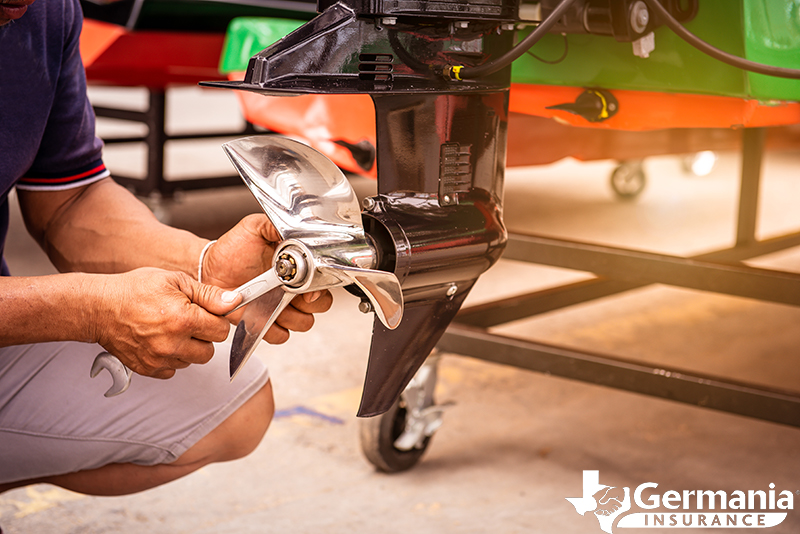
Why boat maintenance is important
Boat maintenance checklist, boat maintenance schedule.
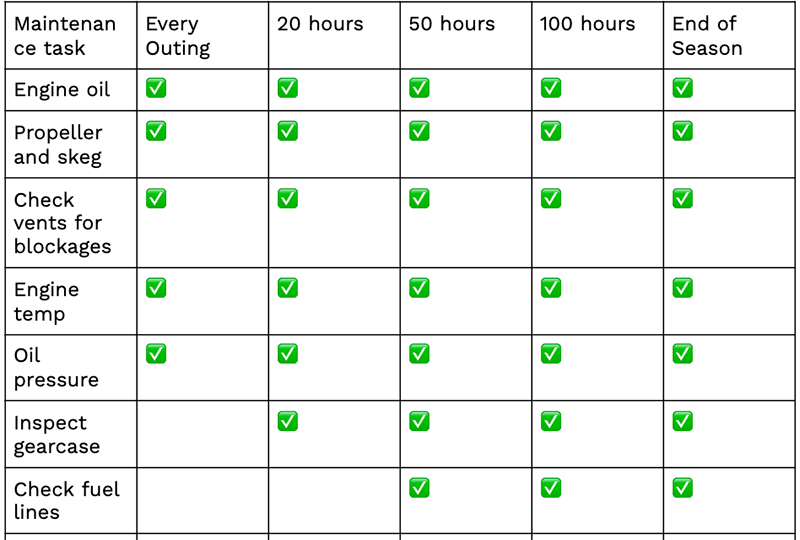
Reliable boat insurance

by Geoff Ullrich
About the Author
Roadside assistance.
We’re here for you, 24/7/365.
855-548-3455
File a Claim
File a claim online , by phone or by contacting your agent.
1-877-GERMANIA
Find An Agent
Find a repair shop.
800-392-2202 | Contact
For a Quote – Click the “Find an Agent” button to locate an agent closest to you
- Germania Credit Union
- Become an Agent
- Agent Community
- Claims Handling
Copyright 2024. Privacy Promise/Security | Site Map
Website By Houston Marketing Firm Brand Tackle

Blanchards Yacht Services
The ''Coolest Yacht Agent'' / Yacht Affiliate

Yacht Maintenance Guide
Keeping your Yacht in tip-top shape is crucial for both its performance and longevity. Without regular maintenance, small issues can evolve into significant, costly problems. By breaking down the process into manageable tasks, yacht upkeep becomes far more approachable and routine.
Start with Routine Inspections . The hull should be regularly checked for any signs of damage or wear. A well-kept hull prevents water from intruding and maintains the yacht’s structural integrity. Also, inspect the engine and propulsion system. Look for any leaks, keep an eye on fluid levels, and make sure all components are operating smoothly. These steps include regular oil changes and filter replacements, which are essential to keeping the power system reliable.

A view of a yacht’s well-maintained wiring system, including battery checks.
Regular servicing doesn’t stop at the engine. The yacht’s electrical systems need just as much attention. Ensure the batteries are in good condition and charged. Be on the lookout for any signs of corrosion or damage in the wiring and connections. A properly maintained electrical system ensures all your navigational and safety equipment works correctly, which is vital for any smooth voyage.
Aside from the technical aspects, don’t forget about the Yacht’s Interior and exterior. Inspect and clean upholstery, teak wood, and other materials regularly. This not only keeps everything looking pristine but also prolongs their lifespan. Outside, check the condition of the deck, railings, and fittings. Reapply protective coatings as needed to shield against harsh marine elements.

The interior cabin of a luxury yacht being cleaned and inspecting, along with exterior stanchions and rigging.
Yacht Maintenance Guide:
1. regular inspection.
Hull and Deck: Regularly check for cracks, blisters, and signs of wear. Ensure that the deck is free from any debris that could cause damage.
Propellers and Rudders: Inspect for signs of corrosion, damage, or wear. Ensure that they are operating smoothly and efficiently.
Rigging: Examine the rigging for fraying, corrosion, or damage. Pay special attention to the shrouds, stays, and halyards.
2. Engine Maintenance
Oil Changes: Change the engine oil and filter as recommended by the manufacturer. This helps keep the engine running smoothly and extends its lifespan.
Cooling System: Check and top up the coolant regularly. Inspect the hoses and clamps for leaks or wear.
Fuel System: Ensure the fuel filters are clean and replace them as needed. Check for any signs of leaks in the fuel lines.
Batteries: Test the batteries and clean the terminals. Ensure they are securely mounted and charged properly.
3. Electrical Systems
Wiring: Inspect all electrical wiring for signs of wear or damage. Replace any frayed or corroded wires.
Navigation Equipment: Regularly test and calibrate navigation equipment such as GPS, radar, and sonar to ensure accuracy.
Lighting: Check all interior and exterior lights to ensure they are functioning correctly. Replace bulbs as needed.
4. Interior Maintenance
Cabinets and Upholstery: Clean and inspect all interior fittings. Repair any damage to the cabinets, upholstery, or fixtures.
Plumbing: Check for leaks in the plumbing system and ensure that all pumps and water systems are functioning properly.
Ventilation: Ensure that ventilation systems are working to prevent mold and mildew buildup.
5. Safety Equipment
Life Jackets and Flotation Devices: Inspect and replace any worn or expired life jackets and flotation devices.
Fire Extinguishers: Check the condition and expiration dates of fire extinguishers. Ensure they are easily accessible.
First Aid Kit: Keep a well-stocked first aid kit onboard and check its contents regularly.
6. Cleaning and Protection
Hull Cleaning: Regularly clean the hull to remove algae, barnacles, and other debris. This helps maintain performance and fuel efficiency.
Waxing: Apply a protective wax coating to the hull and deck to protect against UV damage and maintain shine.
Covering: Use a cover to protect the yacht from the elements when not in use.
7. Winterizing
Engine: Flush the engine with fresh water and add antifreeze to prevent freezing.
Water Systems: Drain water tanks and lines to prevent freezing and damage.
Batteries: Disconnect and store batteries in a cool, dry place.
8. Professional Servicing
Annual Inspection: Schedule an annual inspection with a professional marine technician to address any potential issues that may not be visible during regular maintenance.
Upgrades and Repairs: Consult with a professional for any major repairs or upgrades to ensure they are performed correctly.
Getting professional help is always a wise choice. Regular inspections by marine technicians can uncover potential issues before they snowball into more serious problems. These experts have the knowledge and tools to conduct thorough checks and perform necessary repairs, ensuring your yacht stays in excellent shape.
Are Yachts Hard to Maintain?
Maintaining a yacht can seem daunting, especially for Newcomers to the World of Boating , but it doesn’t have to be overwhelming. Yachts, like any complex machinery, require regular care and attention to stay in optimal condition. The complexity of maintenance largely depends on the size, type, and age of the yacht. Modern Yachts come Equipped with Sophisticated Systems and Technology , which can add to the maintenance workload.
However, with a well-structured maintenance schedule and a proactive approach, the process becomes manageable. While the learning curve might be steep initially, investing time in understanding your yacht’s specific needs and consulting with professionals can simplify maintenance and make yacht ownership a rewarding endeavor.
TYMO Cordless Hair Straightener Brush
Stay Sleek Anywhere with TYMO Cordless Hair Straightener Brush!
Experience flawless hair anywhere with the TYMO Cordless Hair Straightener Brush – Porta ECO. This lightweight, portable straightening brush is designed for effortless touch-ups on-the-go. With a powerful 3200mAh rechargeable battery, enjoy up to 30 minutes of styling on a single charge—perfect for 2-3 uses. The T-GLOSS ceramic-coated bristles glide smoothly, taming frizz and leaving your hair sleek and polished. Safe and easy to use, it features heat-resistant black teeth and an anti-start plug, ensuring you can carry it in your bag worry-free. Elevate your style effortlessly, anytime, anywhere!
How Often Should a Yacht be Cleaned?
Cleaning a yacht is essential for preserving its appearance and functionality, and the frequency of cleaning largely depends on usage and environmental conditions. For regular maintenance, it’s recommended to clean the yacht after each use, especially if it has been exposed to saltwater, which can accelerate corrosion and buildup. A thorough cleaning should be done at least once a month to remove any accumulated grime, algae, or mildew.
Additionally, the hull should be scrubbed and inspected for barnacles and other growths every few months to maintain performance and prevent damage. Seasonal deep cleaning, including waxing and polishing, is also advisable to protect the yacht from the elements and maintain its value. By adhering to a consistent cleaning schedule, you ensure that your yacht remains in pristine condition and ready for your next adventure.
Proper yacht maintenance is not just about keeping your vessel looking good; it’s about ensuring safety, performance, and longevity. By following a regular maintenance schedule, staying proactive with inspections and repairs, and investing in professional servicing when needed, you can enjoy peace of mind knowing that your Yacht is Always Ready for the Open Water . Whether you’re a seasoned sailor or new to yachting, the effort you put into maintaining your yacht will pay off in smoother, safer, and more enjoyable voyages. Keep your yacht in top shape, and it will reward you with countless memorable adventures on the sea.
**Our Website contains affiliate links. This means if you click and make a purchase, we may receive a small commission. Don’t worry, there is no extra cost to you. It’s a simple way you can support our mission to bring you quality content**.
Discover the epitome of luxury and comfort at Pan Pacific Hotels Group . Whether you’re seeking a serene retreat or a vibrant city stay, our world-class hotels and resorts offer unparalleled experiences across the globe. Indulge in exquisite dining, rejuvenating wellness, and exceptional service tailored to your every need. Elevate your travel with Pan Pacific – where every stay is an unforgettable journey.
Leave a Comment Cancel reply
Save my name, email, and website in this browser for the next time I comment.

Boat Maintenance Checklist For Beginners (30 Important Steps)
Boat maintenance is crucial to keeping your boat in good working order.
One problem for new boat owners is not knowing how to maintain their new purchase.
This guide will help you take care of your boat to extend the lifespan of the boat. It will also help to ensure that you do not encounter any issues out on the water.
Table of Contents
If you winterize your boat, you will want to make sure you run through this checklist every new boating season.
The Engine (7 Things To Check)
Perhaps the most crucial part of your boat is the engine. Engine failure out on the water can be dangerous and hard to deal with. It is much better to prepare your engine on land when necessary repairs are easier, and parts will be accessible.
I myself have been on a boat that was not properly serviced before departure, and we stalled out in the water without the ability to get back on our own.
This can be scary and is completely preventable with proper care and attention.
Here are all the things that need to be done or checked with your engines:
- Replace engine fluids and filters at least annually, no matter the condition.
- Inspect all cooling system hoses and clamps. Make sure to replace when necessary.
- Inspect the fuel system. Check all fuel hoses. Look for leaks or damage. Replace anything that is not in top condition. Damage can include softness, brittleness, or cracks.
- Ensure exhaust and ventilation systems are working properly.
- Inspect the raw water pump; the rubber impeller should be replaced annually.
- Inspect all engine cables, hoses, and everything else connected to the engine.
- Inspect and clean off your spark plugs (on gas engines.) Make sure to replace when necessary.
Electrical Parts (6 Things To Check)
Almost just as important as the engine is the electrical system parts. The electrical system can be difficult to maintain after you have already set off.
You will also want to make sure you do not wear down the battery by leaving the lights, radio, or other electrical on for too long without the engine running. Just like it would in your car, this can cause the battery to die.
If your battery dies while you are out on the water, it can be challenging to find someone to help you jump it.
For the electrical system, you will want to check the following:
- Inspect the battery condition and the battery cable connection to the engine. Make sure there are no signs of corrosion. Clean or replace if necessary.
- Check battery switches. These can wear out. Replace if necessary.
- Inspect the breaker, fuses, and other components for corrosion. Replace if needed.
- Check all lights. These can be necessary at night, and you can even get in trouble without properly functioning lights at night.
- Check all other electrical devices used on the boat, especially any bilge pumps. Replace if needed.
- Make sure you have the proper jumper cables for possible emergencies.
Steering system and Thru-hulls (5 Things To Check)
Like the other parts of the boat, you will want to make sure that the steering system is functioning properly while still on land (or at the dock.) Any thru-hull fittings should be checked and maintained.
If you launch your boat and then find out that you have no steering, it cannot be easy to remedy the situation while you are out on the water. A failing through-hull component can sink a boat quickly.
Steering and thru-hull things to check include:
- Check the hydraulic steering systems, including an inspection of the fluid level. Check the hoses and connections for leaking. Replace as needed.
- Check the condition of the steering cables. Replace any frayed cables.
- Make sure the steering system is functioning properly, grease if needed.
- Check the condition of the rudder or outboard bearings.
- Inspect all through-hull fittings and valves. The fittings must be secure, the valves must operate, and the hoses and clamps must be in good condition.
Motor, Propeller & Hull (7 Things To Check)
You need to make sure you inspect all your major boat operating components. All boat systems take a beating while on the water, and most people close the season down with the plan to “replace that next year.”
If that describes you, you will want to make sure that you don’t forget and actually replace it before you go back out.
This includes the motor, propeller, and hull of your boat. If these are not in top condition, it can cause issues later, hopefully not when you are out on the water.
Boat component maintenance includes:
- Inspect propellers. Make sure they are not dinged, cracked, bent, or otherwise damaged.
- Make sure the propeller is secured properly. Replace bearings when needed.
- Make sure the hull doesn’t have any cracks, blisters, or distortions. Clean the hull before you set out for the season.
- Apply any anti-fouling paint as required before you launch.
- Make sure you replace any pumps, switches, or other components that aren’t working before you launch.
- Make sure your anchor is in good condition as well as it’s “rode” (the rope or chain attached).
- Inspect all other areas for cracks, especially where things are attached or welded.
Safety Equipment (5 Things To Check)

You might not think of safety equipment as part of your boat itself or needing maintenance, but they are just as important as boat maintenance.
It is the law that all your safety equipment be present and in good working condition. If it is not, you could incur fines or other consequences.
The safety equipment checks should be as follows:
- Ensure all life jackets are in the proper condition and that there is one for every person on board. This is the law.
- Make sure your fire extinguisher(s) is the proper one for your boat and that it is stored and charged.
- Make sure you have a carbon monoxide detector for all enclosed spaces that your vessel might have.
- Make sure you have a basic first aid kit on board that is properly stocked.
- Ensure that you have a properly working emergency signal kit that includes a flare gun.
Additional Maintenance That Could be Needed
Every boat is different. This means that boat maintenance is different depending on what type of boat you own.
Below are some possible maintenance items you might have that are not true of all vessels.
Some possible maintenance needed could be:
- If you have a sailboat, make sure your lines, sails, and all additional equipment is in proper working order. Check for tears, frays, or other structural damage to your equipment.
- If your boat has any wood, no matter the amount, make sure you treat it and clean it. Even wood trim needs to be taken care of. This will help maintain the wood and keep your boat looking like new.
- Vacuum any carpet and wipe down all seating and surface areas.
Maintenance Steps to do Regularly
It is essential to keep your boat in good condition that you keep up on all maintenance needed.
Some maintenance will need to be done more than once a season. This will make sure that you have less to do when it comes time to winterize or store your boat.
This also will help to make sure your boat stays nice throughout the entire boating season.
Some Regular Maintenance Includes:
- This is even more important if you go boating in saltwater. If you are boating in saltwater, you should wash your boat with fresh water every outing. Saltwater can corrode your boat’s metal and can damage your fiberglass if left on too long. You also want to clean and wash the interior regularly to maintain good condition.
- Algae and other growth can damage your hull.
- This is easy and can be done at home with the proper tools.
- If you don’t have to change it, you also want to make sure that there is still the proper oil amount in your engine.
- Shallow water, rocks, trees, and other objects can damage your propeller, and you might not even know.
- A damaged propeller can damage other parts of the propulsion system.
- Even small damage can cause excessive fuel use, steering or other performance issues, or further damage.
- Regularly applied waterproof grease or another product is also a good idea, so the propeller doesn’t corrode and perform poorly.
- This might seem like a no-brainer, but it can be easily overlooked.
- It is always required to have one for everyone.
10 Extra Maintenance Tips When Winterizing Your Boat:
If you do not live somewhere warm all year long, you will most likely have to winterize your boat.
This will prevent damage to your boat during the cold winter months.
During the winter, your boat should be out of the water in a storage area.
Ideally, your boat should be stored in a climate-controlled building, but this is not always a possibility.
If you can’t afford a climate-controlled storage area, you can use shrink-wrapping on your boat. This can help with protection but can also be costly.
No matter what you can afford, your boat should be properly covered and stored.
The best thing to do before you start winterizing is to check your manual. Most manuals will come with recommendations for winterizing your particular model.
The steps for winterizing your boat are as follows:
- Change the oil. It Is best if the engine is slightly warm to allow it to drain better. While doing this, you should also change the oil filter.
- Flush the engine with non-toxic antifreeze.
- Change your transmission fluid.
- Winterizing your fuel varies depending on your vessel. Some manuals suggest filling the tank and adding a stabilizer, and some advise adding a stabilizer to what is already there.
- Thoroughly clean your interior so no dirt or grime sits on your interior that could cause stains or other deterioration.
- Make sure your hull and all other aspects do not have barnacles, algae, or other growth. It is recommended to pressure wash and wax the hull.
- Check the hull for any cracks, blisters, or breakage. If you see anything, it should be taken care of immediately.
- Remove any possible food or other perishables from the boat before covering.
- It may also be beneficial to remove any sensitive technology if you are not storing your boat in a temperature-controlled facility. Overly cold or hot temperatures can decrease the lifespan of your electronics.
- Properly cover and store your boat in a shelter.
The proper winterization and storage of your boat can extend its lifespan, preserve its condition, and keep it running smoother for longer.
What Else Do I Need To Know About Maintenance?
It is important to keep up on your boat maintenance. A boat is a large investment, and you want to make sure that you protect that investment.
While this guide is important and covers what you need to know, you should also check your boat’s manual for the manufacturer’s suggestions.
They may have more specialized or specific instructions for your particular boat.
It is also beneficial to check the owner’s manuals for all the equipment you purchase for your boat. This can include warranties or care instructions that will help you maintain your purchases’ integrity and life.
The major thing to keep in mind is that you need to maintain constant vigilance and upkeep. Something as simple as not regularly washing your hull, keeping up on your propeller, or any other oversights can cause problems to your boat later.
Cleaning is also important. If you ever decide to sell your boat, you will better off the nicer your boat looks. With proper cleaning, waxing, shining, and upkeep, you will be sure to get more money than you would if it looks deteriorated, torn up, or damaged.
Owning a boat is an investment of time, money, and hard work. Most boat owners know this going in and do not want to try and restore or fix up a boat that has not been properly cared for in the past.
As someone who has previously purchased a boat, I can tell you that as a potential shopper, if I see the outside is not maintained, I worry for the engine’s integrity.
Boat maintenance is an investment that is worth making!
Maintenance Costs You Should Expect
There are a lot of costs associated with boat ownership that goes beyond the purchase price.
These costs include maintenance, gas, safety equipment, storage, and winterizing costs.
Maintenance costs average around 10% of the purchase price per year. This includes cleaning, waxing, painting, new filters, and other regular replacements.
The cost could go up for every non-regular object that needs to be replaced. On boats kept in water, there are anti-fouling paint and dockage fees.
Maintenance costs can vary highly depending on the type of the boat, the boat’s age, and the boat’s condition.
We have written an extensive guide with prices on boat detailing . It’s a great resource to check out if you feel like you should leave the professionals’ job.
Sailboats will accrue more costs because you will need to maintain the sails, lines, and related items regularly.
Gas And Fuel
Gas is a fairly regular expense that is necessary for the enjoyment of your boat.
You will also need to plan for where you buy your gas. As a long-time boater, I can tell you that what you would pay at a marina is much higher than at a gas station.
If you don’t plan on driving to buy your gas and instead choose to go to a marina, make sure you are prepared for the upcharge you will get for the convenience.
Safety Equipment
Replacing, recharging, or the initial purchase of safety equipment can also add up.
Life jackets can be as low as $30, or they can be over $100. If you need one for every person on board, this can quickly add up.
Life jackets will most likely not need replacing every year, but they will eventually need to be replaced. The integrity of a life jacket should not be compromised, or it may not work when needed.
It is also likely that you will need to replace them if you have children who are growing. Lifejackets need to be compatible with the weight of the wearer.
Storage & Docking
Storing or docking your boat can also come with a cost.
Popular marinas often charge high fees to keep a boat there. This can vary greatly depending on location and marina.
It would be best if you also thought about winter storage costs.
If you don’t have storage yourself, you will most likely have to rent something.
This can vary as well depending on whether you opt to rent climate-controlled storage or outside storage and how you cover your boat, such as shrink-wrapping.
Click to share...
Boat Maintenance Checklist
Use this handy checklist for boats/yachts before getting back on the water.
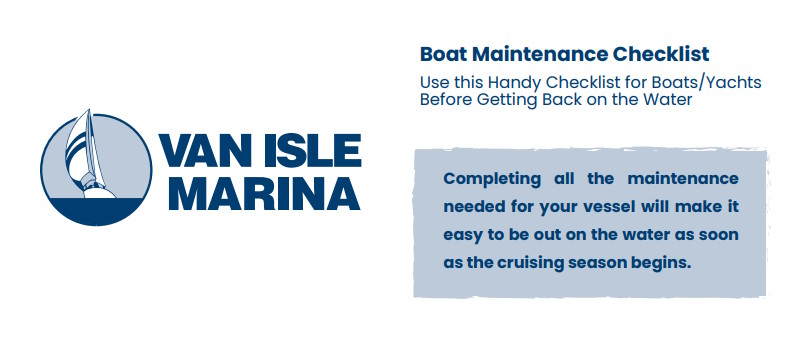
Boat maintenance is a key part of keeping your boat cruising smoothly for optimal enjoyment, safety and resale value. At Van Isle Marina, we know there’s a lot to think about when it comes to maintaining your boat. This is why we’ve created this handy cheat sheet for the care and keeping of your boat.
It’s a good idea to go through this boat maintenance checklist at the end of the season. This will give you plenty of time to schedule the required boat repairs and maintenance during the low season.
Completing all the maintenance needed for your vessel will make it easy to be out on the water as soon as the cruising season begins.
Boat Mechanics
To ensure a smooth trip, take the time to inspect the engine and all its parts. Replace items as needed to ensure your boat is in good working order.
- Check the engine and operating temperature
- Check propeller for any damage
- Test steering for any leaks
- Check transom mount (if using an outboard)
- Check fuel lines for weak points or leaks
- Do an oil change
- Check spark plugs
- Check fluid levels
- Check gearcase for water
- Check belts, cables and hoses
- Lubricate fittings (where required)
Boat’s Electrical Systems
Because your boat experiences a lot of vibration and hull flex, it’s important to properly troubleshoot and maintain electrical components.
- Check battery charge level
- Check battery connections and cables
- Look for any acid leaks around terminals and clean as needed
- Replace battery if needed
- Check and/or replace interior and exterior lighting and wiring
Hull of the Boat
As the watertight part of the boat, the hull maintains the structural integrity of the boat, protecting the cabin, cargo, engines and all other components. That’s why hull maintenance is crucial.
- Check for any signs of leaks
- Check for cracks or stressed areas
- Check thru-hulls for rust
- Check stringers
- Wash with a pH balanced soap
- Wax or paint hull
Boat’s Electronics
Not to be confused with electrical systems, the onboard electronics of the boat let you navigate and communicate effectively.
- Check wiring for any corrosion
- Check voltage levels
- Update firmware to latest version
Boat’s HVAC System
Ready access to water as well as reliable heating and air conditioning are essential to an enjoyable trip out on your boat.
- Check and refill water tank
- Check the drain for clogs
- Check for condensate in pan under evaporator
- Clean air filters and raw water strainer
- Reverse cycle the system to make sure heating is available
- Check the water pump impeller and condenser coil for any build-up
Upholstery and Canvas on Board
Seasonal maintenance is needed to preserve and extend the life of the on-board upholstery and covers.
- Check for mould and mildew – clean as needed with vinegar solution
- Remove and wash canvas
- Check for waterproofing – reapply waterproofing spray if needed
Safety Equipment on Board your Boat
Ensure your safety equipment is in good working condition and within the expiry date. Replace anything that has expired or is in poor condition.
- Check flare(s)
- Check fire extinguisher
- Inspect lifejackets for tears or missing parts
- Inspect and restock first aid kit
- Check flashlight and batteries
- Check and refill spare gas can
- Check EPIRB (Emergency Positioning Indicating Radio Beacon)
- Check tender for damage
- Check paddles and outboard motor on tender
Click here to download our boat maintenance checklist as a PDF.
Getting ready to get back out on the water this spring? Come and see us first. At Van Isle Marina, we’re a one-stop shop for all your cruising needs, from oils and additives to charts and tackle. We offer a great marine fuel discount program for recreational and commercial vessels. Enjoy full-service assistance with dock lines and fueling from our marine gas station team. We’re open 8 :00 AM – 4:00 PM daily (winter) and 8:00 AM – 8:00 PM daily (summer) and we look forward to seeing you in beautiful Sidney, BC. Contact us anytime for a service request for moorage, haul out, dry land storage and more.
250 656 1138
2320 Harbour Road, Sidney, British Columbia V8L 2P6 [email protected]
Marina Services
Marina Layout
Yacht Sales
- Link to Facebook
- Link to Instagram
©2024 Van Isle Marina | Design by Caorda
- Seller Market Analysis
- Trade Your Yacht
- Sold Yachts
- We Buy Boats
- Exclusive Listings
- Yachts for Sale
- New Yacht Builds
- Nautor Swan Yachts
- Sichterman Yachts
- Luxury Yacht Charters
- Search Charter Yachts
- Charter Management
- Luxury Events
- Team Members
- Boat Show Events
- North Report Magazine
- Testimonials
- +1.954.900.9988
Blog | Yacht Owners Guide to Superyacht Maintenance
A superyacht is a remarkable engineering feat. With cutting-edge technology, these floating luxury hotels with pools, gyms, tenders, and more are designed to travel upwards of 12 knots per hour while cruising. The amenities that accompany a superyacht are just as remarkable. With all the comforts of home and then some, superyacht owners require a passionate crew and must perform regular maintenance to preserve a luxurious yacht ownership experience.
The ROI of a superyacht pays in fun, relaxation, and unique excursions with friends and family. Using schedules for many yacht maintenance tasks can help improve reliability, avoid repair costs and make managing your vessel a breeze. Software management systems can help organize safety drills, cleaning schedules, tender servicing, and essential operating systems.
Management Software

Whether you hire a yacht management company or rely on a passionate crew, maintenance management software tools can help improve the consistency, communication, and data organization of your team. Documentation of yacht maintenance is valuable for resale, and service software can produce comprehensive data reports such as annual expenses. Superyacht maintenance plans for yachts span 5, 10, or even 15 years, so transferring maintenance and repairs data with the yacht is necessary. Management software allows this data to be easily shared with potential buyers.
Maintenance software can also help streamline communication between management companies, captains, engineers, and owners. Streamlining processes creates efficiency and simplicity, making it fun to be an active superyacht owner.
Drills are essential to safety aboard a superyacht. While no one ever wants to put emergency training to the test with an unexpected event, a well-trained crew can minimize damage and save lives – added insurance and peace of mind for most yacht owners. Every yacht has different equipment and tools, and the crew needs to become familiar with all life safety systems as well as their individual roles in the event of an emergency. Following the International Maritime Organization guidelines can provide a framework for these drills.
Diligent cleaning and protective coatings, such as waxing, will keep your yacht sparkling. If your vessel contains beautiful woodwork, regular treatment or varnish will help maintain its shine and keep it looking flawless.
Maintaining a clean yacht is most manageable when performed on a schedule. Cleaning is also an efficient time to inspect the engine room, hatch seals, latches, chrome handles, or railings. Paired with a system to report any corrosion or potential concerns, your vessel can remain a safe, well-maintained cruising machine.
Interior cleaning also plays a role in maintaining a superyacht and easing the financial burden than can come from avoidable equipment malfunctions. Proper cleaning can prolong the life of current interiors and postpone the need for refits. Members of your crew can keep the interior meticulous while you focus on relaxing.
Tenders and Toys

Another appeal of superyacht ownership is all the toys, but audio/visual systems, tenders, scuba equipment, jet skis, and more all need maintenance for optimal performance.
Because daily activities can change based on the weather, regularly servicing tenders and toys allows you to adapt plans accordingly. Coordinating these maintenance schedules and documenting them with reports is all part of superyacht maintenance.
Operating Systems
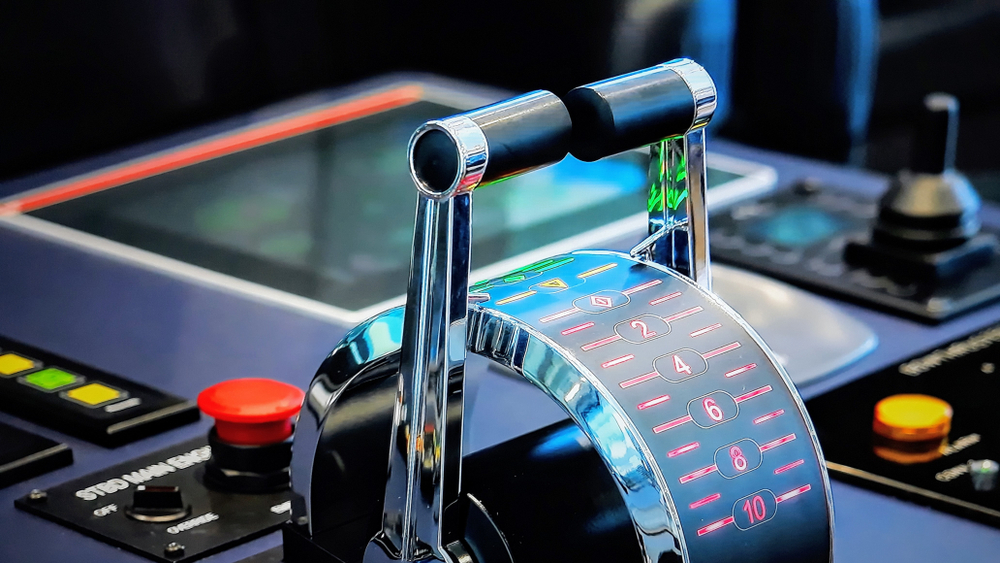
Regularly ensure that dock lines, batteries, and bilges are dry and that pumps are working. This is essential to the safety of a superyacht. Air conditioning units and toilets are also necessary to provide a comfortable experience for guests, so it’s critical to keep those systems in good working order.
Engines are a more substantial undertaking. Running systems, changing oil filters, and monitoring pumps are a few critical tasks. There are several ways to go about maintaining engines: You can have one or more engineers on your crew, you can use on-shore engineers or a combination of both. It really comes down to the unique needs of your superyacht and how you use it.
Regular superyacht maintenance includes a broad range of tasks required to protect a vessel’s performance, longevity, and value. With the right tools and people in place, you can keep your yacht in excellent condition for years to come.
Book your next yacht charter today at 26 North Yachts .
Recent Stories
Discover the ultimate caribbean adventure aboard “just enough” , swan arrow: nautor swan’s power yacht division latest masterpiece set to debut at cannes yachting festival.

Talk to us Contact Our Team
I understand that by signing up I agree with 26 North’s Privacy Policy .
Welcome aboard!
We have added you to the newsletter.
We have received your information and an agent will get back to you ASAP
Sign up for Yoga On the Docks Tuesdays at 8 AM
We have received your registration. See you on the docks!
Don’t Miss Our Summer Rebate!
- United States
- International

A Complete Guide to Boat Maintenance From EZ Dock

Assets such as cars and boats require regular maintenance to run smoothly and safely. With proper boat care and upkeep, you can expect your vessel to last a long time and be the source of many memories, whether you go boating on lakes, rivers or seas.
Essential boat maintenance goes beyond a visual inspection of your boat every time you head out. You also need to care for your boat after every outing, as well as follow a regular maintenance schedule. Fortunately, many upkeep-related tasks are manageable for most boat owners and do not require a mechanic. However, if you do find you need assistance or a major repair, we recommend turning to the pros so you can extend the life span of this valuable asset.
In this boat maintenance guide, we’ll cover the basics. We’ll show you how to maintain a boat, share boat cleaning tips, answer common questions and more. When you take good care of your boat, you can enjoy a day on the water whenever the mood strikes.
Read the full guide below or jump to a specific section:
- Introduction to Boat Maintenance
Comprehensive Boat Maintenance Checklist
Engine maintenance: the heart of your boat, boat maintenance for different waters, boat maintenance checklist, boat maintenance schedules, introduction to boat maintenance.
A boat is a significant investment, and you want to enjoy it for years to come. Learn why regular boat maintenance is important for your vessel and how to structure your care routine to serve your unique boating needs.
Why Regular Boat Maintenance Is Essential

There’s nothing nicer than seeing a sparkling clean boat when you get to the dock. Regular cleaning and maintenance help ensure your boat looks its best, even as it ages. Aside from the aesthetic appeal, a consistent maintenance schedule provides the following benefits:
- Increased efficiency, which often means lower operational costs
- Less chance of costly repairs down the line
- Increased safety on the water
- Legal compliance
Understanding Your Boat’s Maintenance Needs
The one thing all boats have in common is their ability to remain buoyant — however, that’s where the similarities end. Boats differ vastly in terms of their material, electrical systems and engine placement. Another point of difference is the water they come in contact with — freshwater or seawater. When designing your maintenance routine, be sure to consider your boat’s unique qualities and any manufacturer guidelines. Our boat maintenance checklist covers some helpful pointers for all boat types.
Boat maintenance involves many tasks centered on one main purpose — keeping your boat clean and lubricated. Just as you wouldn’t drive your car without engine oil, you wouldn’t want to take your boat out for a ride without proper fluid levels. Weather conditions and debris will also cause the same level of damage to your boat aas they do to your car’s exterior over time. The same principle applies to boats. For example, a fiberglass boat with a dirty exterior will turn chalky if you don’t wash and wax it regularly.
To help you keep your boat sparkling and in great shape, we cover some of the best cleaning tips. We also explore proper storage options and boat motor maintenance.
Seasonal Prep for Your Boat
For many boat owners, most of their boat maintenance tasks take place in the spring to prepare their boats for a new boating season. Proper maintenance before your boating season ramps up is crucial for improving the performance of your boat and sets the stage for the maintenance you have to perform throughout the season. To help improve your maintenance checklist throughout the boating season, be sure to complete these boat maintenance tasks in the spring:

- Check for and replace deteriorating anodes: Anodes are sacrificial metal pieces that protect the boat’s underwater metal components from galvanic corrosion. The anodes will disintegrate over time, which means you’ll need to replace them. Once they’re about half dissolved, it’s time to change them. If you let them go too long, you risk damage to the other metal components.
- Inspect your propellers: Inspect your boat’s propellers for distortions that could cause excessive vibrating. When this occurs, screws and pins can loosen, causing more damage or resulting in the propeller falling off underwater. Ensure everything is in good condition, all pins are in place and screws are secure.
- Inspect cable jackets: Cable jackets protect the electrical components of your boat. If the jacket is cracked or swelling, it’s corroding and needs to be replaced. Proper replacements are crucial because if the cables fail, you could lose control of the boat.
- Test the bilge pump: Ensure the bilge pump system works properly. To do this, put some water in the bilge and test the pump to see if it removes it. If not, be sure to get it fixed before heading out on the water.
- Inspect safety gear: Check the expiration dates on your fire extinguisher and flares. Replace them if they’re past the date. Ensure they’re in dry areas and easily accessible if you need to use them. Test carbon monoxide and smoke alarms if you have them.
- Check the fuel and electrical systems: Check the fuel lines for soft spots, cracking and brittleness. Look for stains and the smell of fuel around fittings since these are signs of leaks, and replace them as necessary. Keep the electrical system clean and ensure all connections are tight to prevent fire hazards.
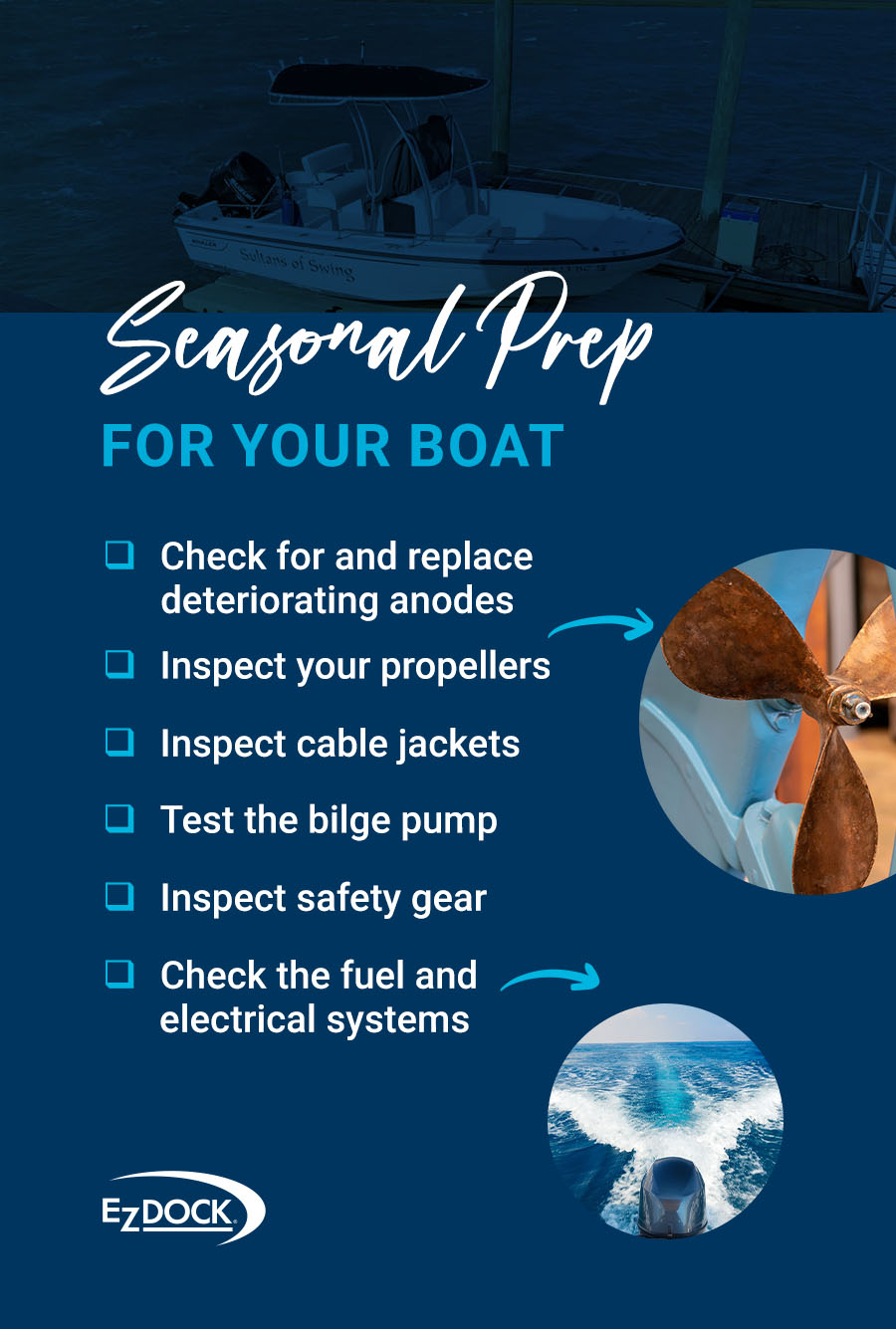
Keeping Your Boat’s Hull Clean and Protected
It’s critical to keep your boat’s exterior clean for several reasons, besides showcasing its beauty. For one, keeping your boat clean helps prevent the spread of invasive species. You never know what plant or animal hitched a ride on your boat, so it’s essential to clean your boat every time you remove it from one body of water to protect the next body of water you launch it in.
Secondly, keeping your boat clean protects the structure of the boat by keeping the finish intact. Over time, the salt from the sea will begin to erode, causing abrasions and scratches that could be costly to remove.
Lastly, a clean boat simply performs better. A dirty hull can increase fuel costs by as much as 30% .

Aim to clean your boat on land to prevent polluting the water if possible. If you need to clean your boat in the water, use safe products and avoid toxic substances. No matter where you clean your boat, you will need to rinse it with fresh, clean water to remove the salt.
Not sure where to start in the cleaning process? Here are some additional cleaning tips for different types of boat materials.
- Fiberglass: Most fiberglass boats have a glossy gel coat finish that protects the fiberglass from salt, sun and other weather elements. You can tell that a gel coat finish needs attention when it takes on a chalky appearance. To keep your fiberglass boat in good condition, make sure to wax or polish it with waxes designed to protect the gel coat. Aim to apply a coat of wax twice a season, preferably in the spring and before you store your boat for the winter. Other than waxing your boat occasionally, make sure to wash away dirt and salt after every outing. Use soap designed for boats and a gentle brush or sponge.
- Canvas: Canvas is the general term used to describe the fabrics used in cockpits, boat covers and other parts of the boat. Proper care will keep canvas looking great and will help the material last longer by keeping its waterproofing properties intact. You can clean canvas using a light brush, mild soap and fresh water. If your canvas has polyvinyl chloride (PVC) windows, never clean the PVC with ammonia-based products. Ammonia will damage the material over time, so it’s best to clean clear PVC with a specialty cleaner.
- Upholstery: You likely have vinyl-covered seating in your boat, since vinyl is durable and easy to clean. Regularly wipe down and clean the seats in your boat to prevent dirt buildup, mold and mildew. Wet a sponge with mild, soapy water, wipe down the seats, wipe away soap residue with a clean, damp cloth, then dry the seats with a clean, soft cloth. If possible, keep the vinyl seats covered or stored away between outings.
- Woodwork: Though wood is typically less common in modern boats, older boats may have some woodwork in handrails, steps, decks or other parts of the boat. Usually, these wooden components are teak, which is a durable tropical hardwood. Clean the teak occasionally with the mildest cleaner designed for teak. Using a soft bristle brush, lightly scrub the teak going across the grain to help keep it in top condition.
Store Your Boat Properly
Proper storage is critical to protecting your boat from weather-related damage, especially during the winter. The point is to keep ice, snow and rain out of your boat while still allowing airflow so mildew doesn’t build up. You’ll also want to prepare your boat for weeks of inactivity, so it functions properly when it’s time to set sail again. Here are some storage options to consider .

- Outdoor: Outdoor storage is a popular method, and allows boat owners to store sailboats with the masts up. Outdoor storage requires a proper cover to protect your boat from the elements. The best way to keep your boat outdoors is to hire a professional to shrink-wrap your boat. Proper shrink-wrapping ensures your boat remains covered and ventilated at the same time. You can cover your boat yourself by fitting a tarp over a wooden frame and placing this over the boat.
- Indoor: Indoor storage is an excellent option because it protects your boat from the weather and the sun. If you do not have room to store your boat in your garage, consider renting a storage unit for the winter. You might also consider dry-stack storage. If you store your boat at a dry-stack storage facility, you’ll keep your boat on a rack in a covered building — just be sure to choose a secure building.
- On the water: Many harbors offer boat storage in the water year-round. Bubblers or de-icers, which bring warmer water from the bottom up to the surface, can protect your boat against ice. Storing your boat on the water may be a practical option if you have a larger vessel and deep water.
Once you’ve decided where to store your boat, follow these tips to prepare your boat for storage. You’ll reduce the amount of work you’ll need to do when it’s time to sail:
- Properly clean your boat.
- Replace cracked hoses.
- Lubricate spark plug holes.
- Replace inline fuel filters.
- Fill the tank to at least 90% and add anti-bacterial stabilizing agents to the fuel.
- Disconnect the battery and store it in a cool, ventilated area.
- Remove all food, carpets and electronics.
- Clean the propeller and shaft and inspect them for damage.
- Apply grease to the shaft.
- Open the drain plugs to allow precipitation to drain out.
- Leave water faucets and valves open.
- If the boat has a refrigerator, keep the door open.
- Flush the engine, water lines and water tanks with fresh water to remove the salt.
- Top off the antifreeze.
Whether you have an onboard or an inboard engine, it is one of the most expensive boat components to replace. Ensure the longevity of this vital piece of machinery with these tips and advice.
Outboard Motor Maintenance Essentials
You don’t have to be a mechanic to maintain your boat’s motor. By taking preventive measures, you can keep your engine running for a long time, and you can preserve the value of your boat. Before you perform engine maintenance, it’s a good idea to check your manufacturer’s recommendations first. With that said, here are a few general tips for caring for an outboard motor before every trip:
- Check that you have fuel and that the fuel tank vent is open.
- Make sure the engine mount screw clamps are tight and secure.
- Ensure the water intake is free of debris.
- Check your propeller for caught fishing line and excessive oil buildup.
After every single trip, whether you travel in saltwater or freshwater, you must flush the motor to eliminate sand, dirt and other debris. To do so correctly, take these steps:

- Buy “earmuffs” or a motor flushing attachment.
- Slip the earmuffs onto the water intake and attach a garden hose.
- Start the engine and allow the water pump to do the work.
- While you’re cleaning your motor, ensure the water pump has good flow by carefully feeling the temperature of the water stream.
- The water shouldn’t be hot, and the output should be strong.
- If the water pump isn’t functioning properly, shut the engine down and insert a piece of wire into the flow tube to remove debris.
- Restart the engine and re-check the flow — if the output is still weak, it’s time to replace the water pump.
- After flushing the engine, disconnect the fuel line.
- Allow the engine to burn all the fuel in the carburetor.
- Turn off the key and battery switch.
- Wipe everything down and spray with an anti-corrosive agent.
- Replace the cowling and wipe it down.
- Keep a canvas or plastic cover on the motor between trips.
Here are more boat maintenance tips to apply regularly:
- Replace spark plugs as needed.
- Regularly check for water in the fuel.
- Keep an eye on the engine’s oil level.
- Check the fuel lines for cracks and wear.
- Check the propeller and engine belts for wear, and replace them as needed.
- Replace damaged fuel hoses.
- Check the fuel primer bulb for cracks.
- Inspect clamps for rust.
- Make sure the tank vent is clear, with no blockages.
Inboard Motor Maintenance: What Is Recommended?
If you have an outboard motor, flush your motor using the above engine maintenance tips. If you have an inboard boat engine, you can easily flush the motor by taking these steps and using an inboard motor flusher:
- Hook up a hose to the motor flusher.
- Place the flusher over the water intake hole.
- Turn on the engine.
- Allow the water to pump through the engine as it idles.
- Watch the water coming out.
- Once the water flows out clear, you’ll know your engine is clean.
- Turn off the engine and water supply, and remove the hose.
Propeller Inspection and Maintenance
The propeller is critical for performance and fuel economy. If you have an outboard or stern drive motor, you should always check the propeller before you launch. Make sure the propeller nut is secure, and tighten it with a deep socket wrench if needed. Look for any damage such as small dents, which could cause you to burn extra fuel. A couple of times a year, remove the propeller to grease the shaft and make sure nothing has gotten wrapped around it.

Whether you enjoy boating in calm freshwater lakes or taking on the rough seas, you’ll need to clean your boat thoroughly once you return to the dock. However, the type of water will significantly impact your cleaning and maintenance routine. Discover the key differences between freshwater and saltwater boat maintenance.
Freshwater vs. Saltwater Boat Maintenance
Boats are generally marketed as “saltwater” or “freshwater” vessels, yet it’s possible to use them interchangeably. While transitioning from saltwater to freshwater is relatively simple, maintaining a boat in saline waters is more complex. Before launching your boat in a new body of water, you’ll need to assess the hull’s structural integrity. If your boat will now be coming into contact with rough seas, your hull will need to stand up to the force.
Another consideration is the anodes. These vital components protect the metal elements of your boat, and you’ll need to replace them annually. If you are transitioning your boat to saltwater, you’ll need to use aluminum or zinc anodes. However, converting your boat into a freshwater vessel will require magnesium anodes.
Since salt accelerates corrosion , you’ll need to upgrade your maintenance routine. Try to do the following critical tasks as soon as possible after saltwater exposure:
- Clean your boat: Wash your boat with fresh water to remove salt residue and protect its finish. You’ll also need to clean the seats with water and soap to remove salt and dirt. If salt remains on your boat for too long, it can start to corrode metal components.
- Flush the engine: Flush your engine with fresh water as soon as possible. Doing so will prevent corrosion on the inside of the engine and keep salt from collecting in the lower unit.
In addition, you’ll need to enhance your maintenance routine by adding the following tasks:
- Remove barnacles: If you’re planning to store your boat in seawater, periodically remove barnacles and algae from the hull. Keeping your hull free of organic matter helps you to move swiftly through the water while limiting structural damage.
- Maintain the paintwork: A layer of durable paint offers additional protection to your hull. A good rule of thumb is to repaint your boat every two years. However, you may need to do this more or less frequently, depending on the paint’s condition.
- Clean your trailer: Trailer components — like boat materials and elements — will corrode if not rinsed down thoroughly. Hose down every part of your trailer after transporting your boat.
We have already covered a lot about how to maintain a boat, from prepping your boat for storage to flushing the engine. To narrow things down even further, we put together this basic boat maintenance checklist. Having a boat maintenance checklist helps you keep track of the parts of your boat that need attention. Check the items on this list as often as possible, and you’ll enjoy peace of mind throughout your voyage.
- Engine: Periodically look over the engine and check for cracked hoses and loose belts, which you should replace immediately. Look for corrosion, and make sure the outboard motor is securely in place.

- Battery: Your boat’s battery is the heart of your boat. Without the battery, your engine won’t start, and electrical components won’t work. Take good care of your battery and check it at least once a year, or more often during boating season. Note that batteries naturally degrade over time, so this is something you don’t want to neglect. Check the battery’s charge with a digital multimeter, and inspect the connections for corrosion. Use a wire brush to clean the connectors if needed.
- Bilge pump: The bilge is the bottom part of the boat that collects excess water, and the bilge pump is the part that removes water from the bilge. If the bilge pump doesn’t work, your boat could sink. To keep your boat afloat, check the pump hoses for debris that could cause clogs. Also, consider adding a backup bilge pump.
- Electrical lines: The electrical lines need to be in good condition to keep the electrical system on your boat up and running, and deteriorating lines could be a fire hazard. To prevent electrical lines from wearing down, keep them clean, and use a digital multimeter to make sure everything’s working right.
- Oil and filter: Stay on schedule when changing the oil and oil filter. Failing to change the oil could damage engine parts. To change the oil, let the engine run for about seven minutes, then turn it off. Next, place a container under the drain plug. Remove the drain plug and loosen the screw above. Let the oil drain out for about 30 minutes. While the oil drains, change the oil filter. After the oil has drained out, replace the drain plug and tighten the screw. Fill the engine with the proper oil.
- Other fluid levels: To ensure your boat runs properly, periodically check other fluid levels such as power steering fluid and coolant.
- Hull: Inspect the hull and look for cracks or blisters. Make sure drain plugs are in place.
When you perform regular maintenance tasks, you ensure your boat functions at its best year-round. Creating a maintenance schedule reduces the likelihood of forgetting critical tasks. This maintenance timeline from the Boat Owners Association of the United States is a good place to start.
1. Maintenance Every Use
Whenever you’re about to launch, make sure to complete the following tasks:
- Check the oil and top it up if needed.
- Access the propeller for damage.
- Test the steering movement by moving the wheel from side to side.
- Check the hull for damage and make any necessary repairs.
- Wash the hull and deck.
- Inspect the bilge pump.
- Check the battery for a proper charge.
- Ensure the electric systems work properly.
- Verify that all fire extinguishing systems are present and working well.
2. Every 20 Hours of Operation
After 20 hours of use, complete the following maintenance tasks:
- Check the lower unit for water and refill oil if needed.
- Treat the fuel with decarbonizer.
- Check the engine for proper revolutions per minute (RPM).
- Clean and protect the interior.
3. Comprehensive Checks Every 50 Hours
Once you reach the 50 hours of use mark, add these items to your to-do list:
- Assess fuel lines for degradation.
- Check the steering system fluid level and look for leaks.
- Wax and polish the hull and deck.
- Clean the bilge pump.
4. In-Depth Maintenance Every 100 Hours
After 100 hours of boating, you’ll need to do some more extensive maintenance. Here’s a brief breakdown of the most essential tasks:
- Lubricate grease points.
- Check the power trim and tilt fluid — replace fluid levels if necessary.
- Tighten all accessible bolts and fasteners.
- Complete any paint touch-ups.
- Check the engine mounts.
- Replace the water pump impeller.
- Install new oil and fuel filters.
- Inspect the bow and stern eyes and ensure they’re mounted securely.
- Check the rub rail for damage.
- Book a professional boat inspection with a mechanic.
Before we conclude our boat maintenance guide, here are a few frequently asked questions to help you jumpstart your boating adventures.
1. How Do I Get My Boat Ready for Summer?
Generally, you’ll want to do a thorough maintenance check after you take your boat out of storage and prepare for summer fun. Here’s a brief list of top tasks to complete.
- Clean: Wash and wax your boat.
- Empty the bilge pump: Pump out any water from melted snow or rain.
- Charge battery: Make sure your battery has a strong charge.
- Perform a safety check: Check all lights, the horn and safety equipment. Replace batteries in smoke alarms and carbon monoxide alarms.
- Change the oil and check fluid levels: Change the oil after winter, and check other fluid levels.
- Check registration: Make sure your registration is up to date, and the sticker is in place.
- Put the drain plug back in: Don’t forget to put the drain plug in if you took it out over the winter.
2. What Supplies Do I Need to Maintain My Boat?
You can get away with owning just a few supplies and tools to practice basic boat maintenance. Otherwise, you may have to find tools for specific projects or more involved repairs. Here are some items to have on hand:
- Tools such as a pair of pliers, an adjustable wrench and a screwdriver to make minor repairs
- Long-handled brush or spray wand to wash the boat
- Soap designed for boats
- Anti-corrosive for lubricating moving parts
- Digital multimeter
- Motor flusher
- Small wire brush for cleaning
3. Do I Need to Change My Boat Oil Every Year?
Experts recommend changing the oil for a gas boat engine once a year or every 100 hours. Changing your oil extends the life of your engine, so you may want to change it more often than what the manufacturer recommends.
If you have a diesel engine, change the oil every 50 hours or less.
4. How Do You Maintain a Fishing Boat?
If you use your boat for saltwater fishing, you’ll want to wash it after every use to remove the salt. You’ll also want to change the oil and check the propeller for fishing line regularly. Several times throughout the season, remove the propeller and make sure there is no fishing line wrapped around the shaft. If you find fishing line, have a dealer inspect the gear case. Fishing line can cause leaks in the gear case.
Partner with EZ Dock for Your Boat Maintenance Needs

Proper boat maintenance will keep your vessel running better and longer while creating a safe boating experience for you, your friends and your family. When it’s time to embark on a boating adventure, you’ll need a safe way for you and your boating companions to step aboard. A durable, easy-to-use dock or boat lift system can make anyone feel comfortable getting onto your boat.
Why Choose EZ Dock?
EZ Dock has built its reputation on supplying premium floating dock essentials at a great price. Our floating walkway docks are perfect for the family boater and provide easy access to the boat, whether you’re ready to sail or need to perform boat maintenance. Our docks are easy to maintain, and unlike wooden or metal docks, they are free of splintering and rust. To learn more about our superior-quality boat docks, dock accessories , dock sections, boat ports , and PWC Ports for your waterfront property or business, contact your nearest EZ Dock distributor today !
View EZ Dock Boat Ports
Request a Quote
Related Posts

Ways to Enhance Waterfront Property Outdoor Landscape

How to Build an Amazing Boathouse


Guide to Docking a Boat

17 Fun Water Toys for Your Next Lake Trip

The Best Beach Games for Adults and Kids

How To Coach College Rowing

Best Places to Kayak in New Jersey

Beginners Guide to Navigating a Boat

A Quick Guide to Boat Hull Shapes

What Type of Dock is Right for Your Shoreline?
Be the first to know, sign up to get the scoop on product updates, new product announcements, and everything #docklife ., sign up to receive our email newsletter.
This site is protected by reCAPTCHA and the Google Privacy Policy and Terms of Service apply.
Email Me the Brochure
By submitting this form, you will be signed up to receive exclusive newsletters about our products.
Get your card today

- Pre-paid code

- Buy a Gift Card
Complete Boat Maintenance Checklist
Boat maintenance is crucial for optimal, safe performance. Whether you have a small boat or a larger vessel, regular checks can prevent mechanical issues and guarantee a smooth boating experience with minimal risk of surprise breakdowns and other problems.
Keep reading for tips on keeping your boat in working condition with this simple boat maintenance checklist. Or download the full checklist in printable PFD format: Drive-A-Boat-USA-Boat-Maintenance-Checklist

Preventive boat maintenance guidelines
Before we get into specifics, check out this basic guide to boat maintenance that will help keep your boat in good working condition year-round.
- Use marine parts that are approved by the boat manufacturer and suited to your specific model. It can be tempting, but never use car parts on your boat!
- Store your boat in a dry location away from direct sunlight. Depending where you live, this can be indoors (which is more expensive) or outdoors. The size and model of your boat, and your budget, will also determine your choice. If your boat is stored outdoors, cover the vessel to protect it from precipitation. Boat owners should consider professional shrink-wrapping. For winter storage, some marinas offer storage with bubblers or de-icers to prevent ice formation.
- Regularly check fittings that go through your hull, such as engine ventilation equipment. See below for more engine-specific maintenance tips.
- Always keep the decks and hull of your boat clean and waxed . This not only enhances fuel efficiency but also prevents leaks and extends the lifespan of your boat. Verify that your Hull Identification Number is clearly marked and visible according to USCG guidelines.
General boat maintenance guidelines
The above suggestions are just the tip of the iceberg. For thorough boat maintenance, year-round, take time to maintain the boat exterior, boat engine, and safety equipment on a regular basis. Remember that additional seasonal maintenance is also important.
Checklist: Boat surfaces maintenance
- Regularly clean your boat’s exterior to prevent mildew, erosion, and the spread of invasive species. Wash your boat after each outing to minimize buildup. A clean hull can save up to 30% on fuel.
- Maintaining the hull is equally important. For fiberglass hulls, wax and polish a few times a year to maintain the gel coat.
- Canvas and upholstery should be periodically cleaned with mild soap and water to prevent mildew. Avoid using strong cleaning products on vinyl and PVC.
- Verify that your boat capacity plate is easy to see and clean, so you can easily confirm whether you have an appropriate number of passengers on board.
Checklist: Boat engine maintenance
- Consult your boat engine owner’s manual to follow the manufacturer’s recommendations for oil changes . You will likely need to change the engine oil at least once per season or every 50-100 boating hours.
- Look for corrosion (rust) and oxidation . Be vigilant and take action before these escalate into significant issues.
- Before every trip , check the fuel, oil, battery power, bilge pump, water intake, hull, and propeller. After every trip , flush the engine with fresh water to prevent corrosion.
- Stick to the manufacturer’s guidelines for checking and servicing your transmission .
- Inspect fuel lines, hoses, and electrical lines for wear, corrosion, and leaks.
- Apply lubrication to moving parts and fastenings.
Checklist: Boat safety equipment maintenance
- Before every outing, check all lifejackets on board to confirm they are still in good working condition, including life jackets for children . These may not be a part of your boat, but it is your legal responsibility to wear one while on board, making them an essential element of boating safety equipment.
- Regularly check any elements of the boat that could be implicated in a rescue , such as navigation lights , visual distress signals (including flags) and radios to confirm they are in good working order.
- Check all other safety equipment , including boat fire extinguishers and backfire flame arrestors , ladders and ropes, and throwable PFDs to confirm they are not expired and in good condition.
Checklist: Seasonal boat maintenance
- Beginning of the boating season : Change the oil, inspect the fuel system, and check the electrical system. Clean and maintain bilge pumps, inspect safety equipment, and clean and wax the boat. Ensure your registration and boat insurance are up to date.
- At the end of the boating season: Winterize mechanical systems by draining water and adding antifreeze. Remove and store canvas and loose equipment, and clean and wax the boat. Change oil and filters, fill fuel tanks, and use stabilizing agents to prepare the boat for storage.
Boat maintenance costs
Annual maintenance costs are typically around 10% of the boat’s original price, though this can vary based on size and usage. Regular maintenance efforts are well worth it, as they can extend your boat’s lifespan and prevent unexpected issues.
Get your boating license with Drive a Boat USA!
Maintaining your boat is an integral aspect of the boating experience. In fact, boat maintenance is key to minimizing the risk of breakdowns and keeping your boat running smoothly. Start a new boat maintenance schedule today! Inspect your boat surfaces, engine and safety equipment each time you go boating and at specific points during the year to stay safe out on the water.
Remember, you can learn about boat maintenance and much more by obtaining your state-approved boating license from Drive a Boat USA. Once you’ve passed our online boating exam, you’ll be certified and ready to go!
- USA Boating
Latest Posts
- Everything You Need to Know About Safe Boating with Dogs
- All About Vessel Safety Checks (VSC) in the U.S.
- Common Causes of Boat Fires
- Tips and Tricks for Docking Your Boat
- Diver Down Flag: What It Looks Like and When To Use It
- August 2024
- February 2024
- December 2023
- October 2023
- September 2023
- January 2023
- November 2022
- Get certified now
- Replacement California Boater Card

Published date — 05.01.2024
Yacht Maintenance Tips
The bright light of the luxury of yachting can be so easily dimmed by malfunctioning equipment, aesthetic imperfections, and mechanical issues. It’s no small task keeping your vessel in tip-top shape, so here is a starter to guide you to some of the yacht maintenance areas we can help you with. Your dedicated RYC yacht manager will work with you, your crew, and our network of industry professionals to ensure all of these essential jobs are attended to regularly and to the highest standard.
- Regular Cleaning and Detailing Regular cleaning and detailing will enhance the appearance of your vessel and help prevent corrosion, deterioration, and damage caused by saltwater, sun exposure, and environmental contaminants. From hull to deck, make sure your yacht receives thorough cleaning inside and out to keep it looking shipshape.
- Routine Inspections and Maintenance Checks Prevention is the best cure when it comes to yacht maintenance. Schedule routine inspections and maintenance checks to identify any potential issues before they escalate into costly repairs or safety hazards. Check vital systems such as engines, electricals, plumbing, and navigation equipment regularly, and address any issues promptly to ensure smooth sailing on every voyage.
- Engine and Mechanical Care Your yacht’s engines are its heart and soul, powering you through the waves and across the horizon. Give them the love and attention they deserve by following a regular maintenance schedule, including oil changes, filter replacements, and thorough inspections. Keep an eye on fluid levels, belts, hoses, and other components to ensure optimal performance and reliability.
- Protect Against Corrosion Beautiful sea water may be the lifeblood of yachting, but saltwater corrosion is one of the biggest battles we face as defenders of your yacht. Protecting your yacht against corrosion is crucial by applying anti-corrosion coatings, using sacrificial anodes, and rinsing with freshwater after every outing. Regularly inspect metal surfaces for signs of corrosion and address any issues promptly to prevent further damage.
- Upholstery and Interior Care The interior of your yacht is your sanctuary at sea, providing comfort and relaxation after a day of adventure on the water. Keep upholstery, carpets, and interior furnishings clean and well-maintained to prolong their lifespan and enhance the onboard experience for you and your guests. Invest in protective covers, sunshades, and moisture-absorbing products to protect against sun damage, mold, and mildew.
- Safety Equipment and Emergency Preparedness As with all areas of yachting, your safety should always be a top priority when it comes to yacht maintenance. It is critical to inspect and test all safety equipment regularly, including life jackets, fire extinguishers, flares, and emergency signalling devices. It’s also crucial to ensure that you have a well-stocked first aid kit and that all crew members are trained in emergency procedures and protocols.
- Professional Assistance and Expert Advice Yacht maintenance can be complex, and working with experienced professionals who understand the unique needs and challenges of yacht ownership is essential. Whether you need help with engine repairs, electrical troubleshooting, or hull maintenance, entrust your vessel to our team and we will help you keep it sailing smoothly for years to come.
- Share post:
- Link copied
Related Posts

What is STCW Training?

Why Financial Management is Critical for Your Yacht

How to Start a Yacht Refit

Mental Health Resources for Crew
- Free Templates
- Use for free
Yacht Maintenance Checklist

1. Engine and fuel system
After heavy usage (such as a single, long trip) .
Check coolant and oil levels, and top up if necessary
Check for, follow up and address any fluid leaks
Check oil pads and replace as necessary
If you have reached 100 hours of usage (or as per manufacturer’s instructions), replace the oil and filter
Monthly routine
As per manufacturer’s guidance, apply WD40 to engine, components and control panel to prevent corrosion
If the boat has not been used that month, start the engine and allow it to reach operating temperature
Clean the water strainer
Annual checks
Check engine belts for wear and tension. Replace as necessary.
Check the fuel tank for rust and/or contamination
Ensure the hoses are not cracked and provide enough slack to account for vibration
Thoroughly inspect the tank, hose and fittings for evidence of leaks
Prior to winter storage, check antifreeze level and replace as necessary. Fill the tank prior to storage as per manufacturer’s instruction
2. Electrics
After heavy usage.
Test all batteries for capacity level. Replace if necessary
Check that all wiring remains neatly bundled and secured and is well-clear of the exhaust system and bilge
Check all running and interior lights and replace bulbs where required
Inspect bulkhead and engine connections to ensure there is adequate flex with no fraying
Check that wire connections and terminals remained sealed, with no evidence of corrosion
Check water level of battery
Clean exterior bulb contact points and apply anti-corrosion spray
3. Preventing corrosion
Inspect the hull for evidence of corrosion such as leaks, blistered or peeling paintwork, deposits around stainless steel fixtures or whitish powder on an aluminium hull
Check steering cables, engine cables and connections and gear casings for corrosion
Replace zincs (either annually or every six months as per manufacturer’s instructions)
4. Hull maintenance
Monthly routine .
Inspect for hull, keel and rudder damage and arrange for any necessary repairs immediately. Treat any scratches or gelcoat damage as per manufacturer’s instructions
Check the condition of the teak and renew as necessary
All yachts require an annual haul-out for anti-fouling, zinc replacement (and repainting, where necessary). Contact your maintenance engineer well in advance of your preferred haul-out time (usually winter) in order to arrange this
5. Bilge pumps and through-hulls
Even where using automatic pumps, inspect blges frequently to ensure they are clean and free to circulate
Check through-hull strainers, intake and discharge components to ensure they are not blocked by debris or marine growth
Ensure valve handles are securely attached to enable quick and smooth closure in an emergency
Inspect plugs and hoses for cracking
6. Ensuring crew safety
Pre-departure checks should include checking the presence and placement of all personal flotation devices, first aid kit and flares. These further checks should also be carried out on a monthly basis:
Thoroughly inspect flotation devices for wear or abrasion. If inflation devices are incorporated into a PFD, ensure the cartridges are secure and charged.
Check the use-by date on flares
Ensure fire extinguishers are in their designated accessible positions, and that they have been professionally inspected and appropriately tagged as up to date
Ensure lifelines or rails are in good condition
Test to ensure CO and fire alarms are working
Ensure you are up to date with galley stove inspection and servicing
copies saved
Grow your brand by driving traffic, leads, and sales to your website. Checklists take minutes to publish and can rank as well as blog posts.
Become a Publisher!
Published checklists can be found in Google or our public search. Spammy checklists will be deleted
I agree Nevermind
Related Checklists

VEHICLE ROAD TRIP CHECKLIST
How to take test drive of a car: a checklist, top 10 most expensive luxury cars, please "like" our page before downloading..
Copy this checklist Cancel
Sign Up for Free
This free feature requires you to be logged in..
Important: Your checklist will be saved to your new account.
Login to an existing account.

Boat Maintenance Tips Essential for Every Boater In Sarasota
- Boat Maintenance
- July 7, 2023

Proper boat maintenance tips is crucial for ensuring the longevity and performance of your vessel. Whether you’re a seasoned boater or a newbie setting sail for the first time, understanding the essential maintenance tips is key to enjoying smooth and safe adventures on the water.
In this article, we’ll provide essential boat maintenance tips that every boater should know. From routine inspections and cleaning procedures to engine maintenance and safety checks, these guidelines will help you keep your boat maintenance in top-notch condition.
Boat Maintenance Tips Schedule Considerations
Having boat maintenance tips is crucial for its upkeep and ensuring its long-term safety and performance. Here are some key considerations to keep in mind when developing your maintenance schedule:
- Regular Inspections: Schedule routine inspections to identify any potential issues before they escalate. Inspect the hull, propellers, and other external components for damage. Check the interior for leaks, cracks, or signs of wear.
- Oil Changes: Regularly change the oil in your boat’s engine according to the manufacturer’s recommendations. It helps maintain optimal engine performance and prolongs its lifespan.
- Engine Tune-ups: Schedule periodic tune-ups to ensure your boat’s engine is running smoothly. It includes checking the ignition, fuel, and other engine components.
- Hoses and Belts: Inspect hoses and belts for signs of wear, cracks, or leaks. Replace any damaged components to prevent unexpected failures.
- Fuel Tank Cleaning: Clean your fuel tank regularly to remove sediment or debris that may clog the fuel system. Use appropriate cleaning products and follow the manufacturer’s guidelines.
- Spark Plugs and Filters: Replace spark plugs and filters as recommended by the manufacturer. It helps maintain fuel efficiency and prevents engine misfires.
- Lubrication: Apply lubrication to moving parts such as hinges, throttle cables, steering mechanisms, and trailer components. It reduces friction and prevents premature wear.
- Steering Systems: Regularly inspect and maintain the boat’s steering system, including cables, hydraulic systems, and connections. Ensure proper alignment and functionality for safe navigation.
Remember, a well-maintained boat not only ensures your safety but also saves you time and money by preventing costly breakdowns or emergency boat repair service in Sarasota . For personalized advice and guidance, it’s recommended to consult with a certified marine technician who can provide specific recommendations based on your boat’s make, model, and usage.
Regular Boat Maintenance Tips For Inspections and Repairs
Doing a boat maintenance regularly is crucial for ensuring its longevity and safe operation. Here are some boat maintenance tips to consider for maintenance:
- Visual Inspections: Regular visual inspections allow you to identify any potential issues or signs of wear and tear before they escalate. It can include checking for cracks, leaks, loose fittings, or any other visible damage.
- Fuel System: Assess the fuel system for leaks, proper fuel flow, and clean fuel filters. Ensure that all connections are secure and that the fuel lines are in good condition.
- Exhaust System: Check the exhaust system for any blockages, leaks, or loose connections. Ensure that the exhaust outlets are clear and not obstructed.
- Steering Gear: Inspect the steering system, including cables, hydraulic systems, or mechanical components, for any signs of wear, corrosion, or malfunction. Verify that the steering is responsive and smooth.
- Hull Integrity: Regularly inspect the hull for any cracks, blisters, or other damage. Pay attention to areas susceptible to wear, such as the waterline or areas in contact with the trailer.
- Electrical Systems: Check the electrical wiring, connections, and battery to ensure they are in good condition. Look for signs of corrosion, loose connections, or damaged wiring that could lead to electrical failures.
By performing these regular inspections and boat maintenance management , you can identify and address potential problems before they escalate, reducing the risk of breakdowns or costly repairs. It’s always a good idea to consult your boat’s owner’s manual or seek professional boat maintenance tips to ensure you follow your vessel’s specific boat maintenance requirements.
Storing the Boat in Winter
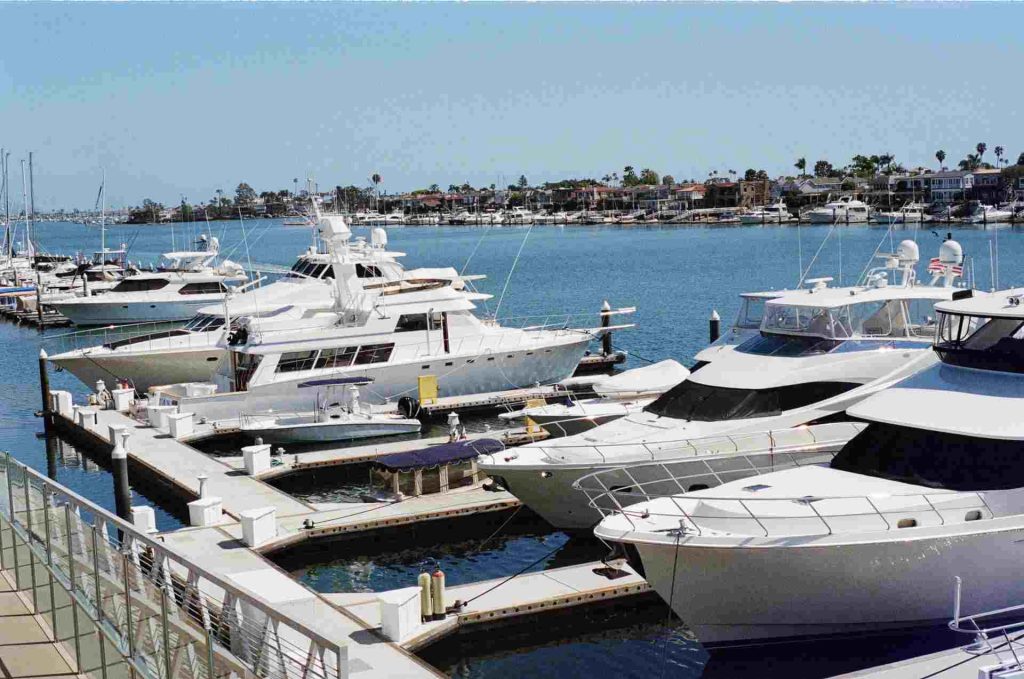
Winterizing your boat is crucial to protect it from the harsh conditions of winter and ensure that it remains in good shape for the next boating season. Here are some boat maintenance tips to remember when storing your boat in winter:
- Gather Winterizing Supplies: Before you begin the winterizing process, ensure you have all the necessary supplies, such as fuel stabilizers, antifreeze, lubricants, and cleaning products. It will make the process more productive.
- Inspect and Repair: Thoroughly inspect your boat, including the engines, electrical systems, and other components. Repair or replace any deteriorated or worn-out parts. Taking care of any issues now can prevent further damage and save you time and money in the long run.
- Choose a Secure Storage Location: Find a secure storage location for your boat, preferably indoors. If indoor storage is not available, choose an area with adequate shade protection from direct sunlight. Excessive heat can cause materials to crack or warp.
- Protect Metal Surfaces: Cover any exposed metal surfaces with a tarp or plastic sheeting to prevent rusting during the winter months. It is especially important if your boat will be exposed to moisture or snow.
- Remove Batteries: If possible, remove batteries from equipment such as radios or GPS units before storing them for an extended period. It helps prevent unnecessary battery drainage and potential damage.
- Follow the Manufacturer’s Instructions: Refer to your boat’s owner’s manual for specific winterizing instructions. Different boats may have different requirements, so following the manufacturer’s recommendations is important.
By following these winter storage boat maintenance tips, you can ensure that your boat preserves good condition and is ready to hit the water again when warmer temperatures return.
Choosing the Right Supplies and Equipment
Choosing the right supplies and equipment for boat maintenance tips is crucial to keeping your vessel in good condition. Here are some important variables to factor in:
- Cleaning Products: Select cleaning products that are specifically designed for marine use. Look for effective products that remove saltwater residue, algae, and other common contaminants. Be mindful of the environmental impact of the cleaning products you choose and opt for eco-friendly options whenever possible.
- Marine Environment: Consider the marine environment in which your boat operates. If you frequently navigate saltwater, choose products specifically formulated to withstand the corrosive impact of salt. Similarly, if you boat in freshwater, you may have different requirements for cleaning and maintenance.
- Quality and Reliability: Invest in high-quality supplies and equipment known for their reliability and low maintenance costs . While they may be pricier upfront, they often offer better performance and durability, saving you money in the long run. Research reputable brands and review product reviews to ensure you choose reliable options.
- Safety Considerations: When selecting supplies and equipment, prioritize safety. Ensure that any products you use suit your specific boat and its components. Follow safety standards and instructions provided by manufacturers. If you’re unsure about any aspect of boat maintenance or equipment selection, consult a professional or seek guidance from experienced boaters.
Remember, proper boat maintenance tips and choosing the right supplies and equipment go hand in hand with keeping your vessel in excellent condition. By investing time and effort into these considerations, you can enjoy many years of safe and trouble-free boating.
The Bottom Line
Proper boat maintenance tips is essential for every boater. We cannot emphasize enough the importance of regular inspections and repairs, as well as choosing the right supplies and equipment. Additionally, it’s important to keep a maintenance schedule in mind to stay on top of any necessary procedures or repairs.
When storing your boat in winter, one boat maintenance tips is taking extra precautions, such as using shrink wrap if needed and removing all electronics from the boat. It will help protect your vessel during those harsh months when no one is out sailing.
If you want to ensure your boat stays in top shape, contact us at The Boat Concierge today. We offer expert boat maintenance tips and services and the right supplies to keep you enjoying the water worry-free.

A GUIDE FOR BOAT TRANSPORT IN THE SARASOTA
Understanding the complications of boat transportation is critical when you have to move to the next destination or attend a boat show. The perspective of

COMPREHENSIVE GUIDE TO BOAT AND YACHT CHARTER AND CLEANING
Being a boat owner, you must be aware of cleaning methods. To extend the boat’s lifespan, boat owners must clean and maintain the materials exposed
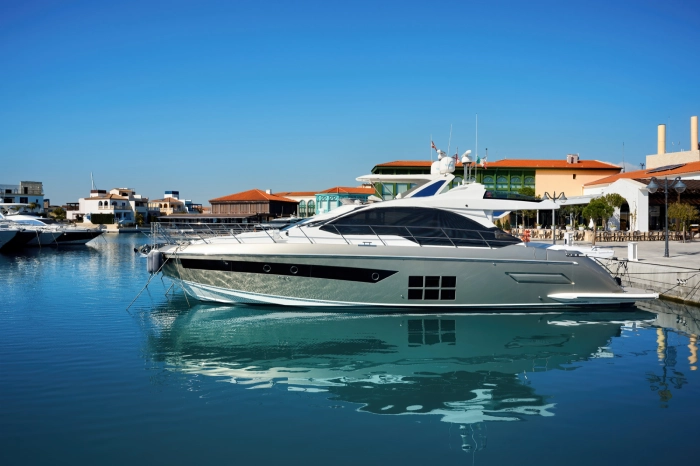
How Often Should You Do Yacht Cleaning
Maintaining a yacht’s cleanliness is essential for its appearance, performance, and longevity. Just as you regularly care for your car or home, yacht cleaning demands
The Boat Concierge is your trusted source in Sarasota for all your boating needs. We make boat ownership easier for you with our expert team and services.
Contact Information
- Phone: (941) 347-2628 (BOAT)
- [email protected]
- Address: PO BOX 3756 Sarasota, FL 34230
Keep in touch with us
Yacht Maintenance and Upkeep: How To Properly Care For And Maintain Your Yacht

Introduction
So you’ve made a dream come true by buying the perfect yacht on the best yacht listing platform online, Yachtify. The freedom to explore the open sea, the feeling of being in touch with nature, and the luxury of having your own private space are some of the things that make yacht ownership so appealing. However, owning a yacht can also be a big responsibility. Yachts are complex machines that require regular maintenance, care, and attention to ensure that they perform optimally and last a long time. This article provides some beginner tips on how to best care for your home on the ocean.
Why Proper Boat Maintenance is Important for Performance and Longevity
The first thing that any yacht owner should understand is that proper maintenance is the key to good performance and longevity. Yachts are complex machines with many moving parts, and all those parts need to work together correctly to ensure that your yacht runs smoothly and lasts a long time. Proper maintenance is also essential for safety reasons. A well-maintained yacht is less likely to break down or malfunction, which can be dangerous when you're out on the water.
Understand Your Yacht's Unique Maintenance Needs
Every yacht is different, and different types of boats may have different maintenance needs. It's important for owners to understand their yacht's specific needs and to follow the manufacturer's recommendations regarding maintenance. Every boat owner should be familiar with the manufacturer's ownership manuals and guidelines to ensure that the yacht is cared for correctly. Maintenance needs can differ depending on the size of the yacht and the type of engine installed.
Create a Maintenance Schedule and Stick to It
One of the best ways to take care of your yacht is to create and stick to a maintenance schedule. This schedule should include all necessary maintenance tasks and how frequently they need to be performed. Regular maintenance tasks should be done every six months. This includes tasks such as changing the oil, replacing fuel filters, and checking the bottom and running gear. By following a maintenance schedule, yacht owners can keep their boats in the best condition possible and address any issues before they become major problems. Maintaining the schedule using a calendar or reminder app will ensure owners do not forget to attend to the necessary schedule, with automatic notifications serving as timely reminders.
Invest in Quality Products and Services for Your Yacht
Investing in quality products and services for your yacht is another important aspect of maintaining your vessel. Quality products like wax, coolant, air conditioning filters, and pumps tend to have longer lifespans and are more reliable, ultimately saving yacht owner's maintenance costs in the long run. Additionally, choosing high-quality services is important to ensure that your yacht is always in good condition and performing optimally.
Common Maintenance Tasks Every Yacht Owner Should Know
Even if a yacht owner does not have experience maintaining boats, there are still a few maintenance tasks that they should know how to perform. These tasks are essential for routine maintenance and keeping your yacht running smoothly.
Engine Maintenance and Service
Engine maintenance and service is one of the most critical maintenance tasks every yacht owner should know. The engine is the heart of the yacht, and it needs to be kept in good condition to ensure that everything else works correctly. This includes changing the oil, inspecting the belts, checking the air intake, and running the engine regularly to ensure that it is operating correctly. Most yacht manufacturers recommend an annual service for the engine to have it checked by a trained technician.
Air Conditioning System Maintenance
One of the essential comfort features of a yacht is the air conditioning system. The system needs to be kept in good condition to ensure that passengers are comfortable. This involves checking and cleaning the air filters regularly, inspecting the ductwork and checking for any leaks, cleaning the coils and flushing the coolant. It is suggested that this be done at least twice a year, depending on the amount of use.
Hull Maintenance and Repair
Hull maintenance is another essential task every yacht owner should know. Hull maintenance includes cleaning, scrubbing, and inspecting the bottom of the yacht. This is important to prevent corrosion, barnacle growth, and other issues that can harm the hull. On wooden boats, it is also important to keep an eye out for any leaks or rot. Any necessary maintenance should be done as and when required. Other aspects of hull maintenance include checking the gel coat, the fuel tank, and replacing the sacrificial anodes.
Managing Maintenance Costs for Your Yacht
Yacht maintenance costs can add up quickly. However, there are a few ways yacht owners can manage these costs and maintain their vessels while still staying within their budget.
Explore DIY Maintenance Options
There are several DIY maintenance tasks that yacht owners can perform themselves. These include tasks like cleaning the upholstery, replacing the propeller and painting the outer surfaces. By doing these tasks, yacht owners can save some money and take pride in knowing they are doing something essential for their boat.
Compare Prices from Multiple Service Providers
When looking for professional services like engine maintenance or hull repairs, it is important to compare prices from multiple service providers to ensure that you are getting the best value. Never settle for the first quote you receive, and be sure to look for professionals who specialize in the specific services you need.
Invest in Maintenance Insurance Coverage
Another way to manage maintenance costs is to invest in maintenance insurance coverage. Some insurance providers offer policies that cover regular maintenance tasks for your yacht. This can help yacht owners save money in the long run by covering unexpected expenses and ensuring that all necessary maintenance tasks are completed on schedule.
Ensuring Your Yacht is Properly Maintained
Local weather conditions and usage patterns can affect yacht maintenance, so it is important to ensure that it is properly taken care of at all times.
Create a Maintenance Logbook
Creating a maintenance logbook is an effective means of ensuring that your yacht is properly maintained. The logbook should include a record of all maintenance tasks completed, including the date of service, the professional who completed the work, and all the parts used. This will help yacht owners keep track of what work has already been performed and what still needs to be done.
Stay Up to Date on Regular Maintenance Needs
As discussed earlier, regular maintenance is crucial to keeping your yacht in good condition. Staying up to date on routine maintenance needs such as oil changes, air filter replacement, and hull inspections will help yacht owners proactively address issues and prevent larger, more expensive issues from occurring.
Perform a Visual Check Before and After Every Trip
Before and after every trip, yacht owners should perform a visual check of the vessel to ensure that everything is in working order. This includes checking the engine, running gear, fuel and water filters, the air conditioning system, and anything else that may impact the vessel's performance.
Factors to Consider When Owning a Yacht
Lastly, there are several factors to consider when owning a yacht, especially when it comes to choosing the right vessel for your needs and budget.
The Importance of Choosing the Right Yacht for Your Needs
Before buying a yacht, owners should think about the type of vessel that is right for their needs. This includes factors such as size, intended use, and budget. A smaller yacht may be less expensive and easier to maintain, but it may not provide the same level of comfort and luxury as a larger yacht.
The Benefits and Drawbacks of Owning a New Yacht vs. a Used Yacht
Another factor to consider is whether to buy a new yacht or a used yacht. New yachts come with the latest technology and modern features, but they can be expensive. Used yachts offer a more affordable option, and they have the added advantage of having some of the wear and tear already taken care of. However, they may not have the latest technology or design features.
The Role of Yacht Groups and Service Providers in Yacht Ownership
Finally, yacht groups and service providers can be an excellent resource for yacht owners. These groups provide a community for yacht owners to connect with other boat owners, share knowledge and tips on yacht maintenance, and offer events and activities that cater to yacht owners. Service providers can help with maintenance and repair needs and can guide yacht owners on how to properly care for and maintain their vessels.
In conclusion, yacht ownership and operation is a wonderful experience, but it requires proper care and maintenance to keep it both safe and functional. Following these tips can help you maintain your yacht correctly and ensure that it lasts for years to come. And if you’re looking to invest in your next yacht make sure to visit the ultimate platform for buying and selling yachts, Yachtify – the home of the best yacht listings online.
- Browse Boats For Sale By
- Browse Brokers
- Boat Category

The newest yacht trading platform online
Unlock the true value of your yacht and set sail for your next adventure with Yachtify today.

An innovative approach to yacht maintenance
Designed for marine engineers, captains, management companies and owner-operators, improves reliability, saves time, and creates transparency..

Enhance Vessel Reliability
- Maximize uptime and safety with PlanM8. Our smart maintenance schedules keep your yacht performing flawlessly, reducing emergency repairs and extending component life. Enjoy peace of mind with more reliable and cost-effective operations.
Streamline Your Maintenance
- With PlanM8, effortlessly schedule all your vessel's maintenance tasks—standard, recommended, or manufacturer-specific. Stay ahead with our pre-generated templates, ensuring you never overlook a component. Pre-order spares easily for yachts of any size, sail or power. Simplify planning, save time.

Enhance Maintenance Visibility
- PlanM8 not only tracks your maintenance tasks but also builds a comprehensive history for your vessel, ensuring seamless transitions between crew, contractors, and even new owners. Our intuitive app, your "Plan Mate" boosts transparency , improving coordination among owners, captains, and crew. Benefit from lower insurance costs, maintained value, and smoother sales processes.
Centralized Documentation, Accessible Anywhere
- Keep all your yacht's documentation and manuals in one place with PlanM8. From maintenance records to warranty documents, easily organize and access everything offline , ensuring you're always prepared, no matter where you are.

Key Features
Offline-functionality.
All vessel manuals, documents, component details and tasks are available offline.
Customized for your vessel
The maintenance app is configured for each boat individually. Template boats are used for easy setup.
Multi-platform
We have the app available in the Google play store, Apple store and on the web.
Well structured boat systems
Each component of your boat is grouped and ordered in systems throughout the app.
Vessel document storage
Boat manuals, safety certificates, crew certificates all in our vessel cloud storage and on your phone.
UPM and warranty claims
Use the app to manage and log unplanned maintenance tasks (UPM) and warranty claims.
Each boat can have multiple users, with different roles and access permissions.
Boat maintenance log
Create and official log of all planned maintenance, breakdowns, modifications and warranty claims
Weekly maintenance report
Every Friday all vessel users get a summary of performed maintenance over the week.
Taylored PDF Reports
Create reports tailored for different purposes such as Operator/Service Manual, Maintenance History, Unplanned Maintenance, and Meter History
his site is an astonishing app for captains and crews. It goes beyond expectations in helping maintain equipment and ensuring thorough checks. Having worked on many boats, I highly recommend this platform. Congratulations on a wonderful venture!
PlanM8 was a life saver when I joined Aenea - CNB 76. It provided a clear guide for maintaining the boat, allowing me to resolve issues quickly. It's a must-have for owners, especially during crew changes. The system's history and notes ensure a smooth handover, providing peace of mind to the new Captain and owner.
After years of searching for a suitable maintenance application, Baxter Marine finally found the perfect solution in PlanM8. It provides alarm reminders, multi-person access, on-the-ground support, and rapid reaction support. Chris and the PlanM8 team have made our job easier. We've installed PlanM8 on multiple vessels and are impressed with its potential and Chris' expertise. We highly recommend PlanM8 to any vessel management team
Plan M8 has transformed the maintenance of my day boat. It simplified the management process, resulting in reduced workload, lower maintenance costs, and improved reliability. I highly recommend it to owners and captains looking to streamline their boating experience.
After a decade of searching, I finally found the perfect software application in PlanM8. It is relevant to my niche of 15m to 30m yachts and has received positive feedback from my crews and owners. The pricing is attractive, and the continuous improvement based on feedback is commendable. I'm excited about upcoming features like the PDF maintenance book and history calendar. This app is a no-brainer for owners with professional crews and will be highly recommended to my clients and contacts. Looking forward to a long-standing work relationship.

- Explore Products
- 1-855-347-3749
- auto On the Road
- home Household
- location Adventure
- circles Turning Points
- Saved articles icon Saved Articles
Progressive
Explore our products
Find an agent near you.
On the Road
Turning Points

What is a boat maintenance schedule?
Assuming your boat sits in the water year-round, there will always be plenty of boat maintenance chores, tasks, and tune-ups to keep you busy onboard. But how often should you change the oil or repaint the hull? These will vary from boat to boat (especially if you have a wood deck to maintain).
How to follow a boat maintenance schedule
A boat maintenance schedule can be broken down by monthly and annual boat maintenance. Follow these boat maintenance tips for what you should do monthly, annually, and beyond to keep your boat in tip-top shape.
Monthly boat maintenance checklist
- Wash the exterior: Scrubbing your boat will keep salt and dirt at bay and extend your gel coat.
- Clean the interior: Clean your boat’s interior by wiping down surfaces and scrubbing the head.
- Check the bilges: Give bilges regularly ensure they’re nice and dry.
- Run the engines: If you haven’t ran your boat in a month, let the engines run for 30 minutes.
- Check the fluid: Check your engine oil, transmission oil, and coolant levels.
- Pump out your waste tank: Schedule a pump-out service or do it yourself at least once a month.
- Check your boat’s hull: To keep your boat’s hull clean, hire a diver to scrub your hull every quarter.
Annual boat maintenance checklist
- Wax the gelcoat: Giving your boat a thorough wax once a year will help maintain its shiny exterior and protects it from the sunshine and salt.
- Wash and waterproof canvas: Give your Biminis and covers a good washdown and reapply any waterproofing solutions or sprays once a year.
- Change the fluids: Change the engine oils, engine oil filters, and fuel filters once a year or every 100 hours of engine runtime.
- Clean out water tanks: To keep your potable water storage nice and fresh, plan on cleaning the tank to kill off any mold or mildew that may have built up over the last year.
- Service waste treatment systems: Whether you use storage tanks or an onboard sanitation system, it’s wise to have these systems looked at annually.
- Request a vessel safety check: The U.S. Coast Guard offers free vessel safety checks for all boat owners. Schedule an in-person inspection or follow the online guide to doing it yourself.
Other boat maintenance tips
It’s also a good idea to perform a yearly top-to-bottom boat inspection. An annual inspection is good to do as part of winterizing your boat each year. Hire a mechanic (or do it yourself if you’re knowledgeable) to inspect your entire boat thoroughly. Depending on the water conditions in your harbor, you’ll probably want to haul your boat out every two or three years to repaint the bottom.
Regular boat maintenance is a lot of work, but for boat owners, it’s a labor of love with an occasional curse here and there. Learn more about buying a boat , common boat types and the difference between an aluminum vs. fiberglass boat .

The Wife Aquatic
Jaclyn her husband and their dachshund mix are full-time live aboards. Sharing their adventures in boat life on their blog The Wife Aquatic.
- Progressive Mark Explore our products menu
- share icon Share article menu
- Save article Save article Remove shared article Remove saved article
Share article
- facebook Share article on Facebook
- pinterest Share article on Pinterest
- link Copy article URL to clipboard https://www.progressive.com/lifelanes/adventure/boat-maintenance-schedule/
RELATED ARTICLES
save on boat insurance today with progressive

Should you hire a boat captain?

What is a capsized boat?

Boat cleaning tips

What Is Shallow Water Boating?

How old do you have to be to drive a boat?

Boat Maintenance on Autopilot
Your boat is your escape, your sanctuary, your joy. Let MaintenanceROS be your partner in keeping it that way. With our personalized maintenance scheduling, we'll track your equipment and notify you of upcoming tasks, so you can focus on enjoying the water. Leave the details to us and experience worry-free boating like never before.
Sign up for a free 30 day trial
We care about the protection of your data. Read our Privacy Policy.
Intro Video
A quick overview of MaintenanceROS
Key Features
Discover how MaintenanceROS can help you stay on the water
Quickly assess your boat’s Overall Maintenance Status with our convenient Dashboard. See what tasks are upcoming and prioritize your maintenance.
Custom Maintenance Schedule
You can create a personalized, custom maintenance schedule for your boat, based on the equipment you have onboard.
Predictive Maintenance Scheduling
Update your Equipment Log Book to track equipment usage and we’ll predict when certain maintenance tasks will be due, based on your actual usage.
Verified Schedules
We maintain a library of verified official maintenance schedules for marine equipment so you can quickly build your personalized experience.
Notifications
Personalize how and when you want to receive notifications of maintenance tasks. That way you can slot the time required for boat work into your schedule.
Maintenance History
Easily look up when maintenance tasks were completed. And if the day comes to sell your boat, you can show prospective buyers the verified maintenance history.
Enjoy Your Boat
More Time On The Water
Properly maintained equipment is less likely to suffer breakdowns, meaning you spend more time on the water, and less time fixing your boat.
Sail Confidently
Increased Safety & Reliability
Set to sea confidently, knowing that your equipment is in proper working order and no maintenance tasks have been forgotten.
Decreased Ownership Cost
Staying on top of preventative maintenance for the equipment on your boat can help you avoid costly and avoidable repairs.

MaintenanceROS highlighted several tasks that slipped through the cracks and helped me quickly address them. With its powerful features, I feel confident about staying on top of everything. Frank C. S/V Galatea - Leopard 46
Manufacturer Partners
We've partnered with the following companies to help make sure we provide you with the latest and greatest of maintenance schedules for their boats and equipment.

Interested in become a partner? Read about our partner program →

Let's Try
Try MaintenanceROS for FREE
See for yourself how MaintenanceROS can transform boat ownership. Keep your boat in top condition and spend more time on the water and less time stuck on the dock.

Thursday Showroom Hours: 8:00 AM - 6:00 PM Service and Parts: 8:00 AM - 5:00 PM
Change My Store
- No results were found.
Schedule Boat Maintenance Today
Our service team consists of factory-certified technicians who understand that not only do you want to keep your boat running smoothly, but that your boat is also an investment. Our top-notch team and facilities will keep your boat in top shape. Take advantage of the MarineMax Experience with different avenues to help keep you on the water. We can't wait to see you on the water!
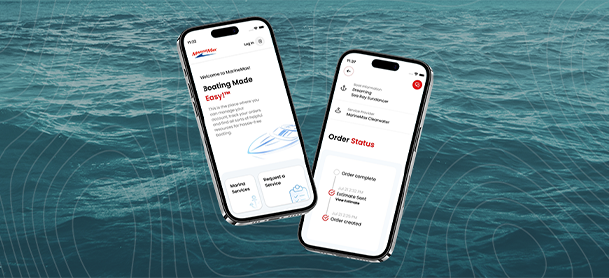
Schedule Your Service Online!
- Request Service Online
- Download the MarineMax App

Parts & Accessories
- View Parts & Accessories
- Reach Out to Our Sales Team
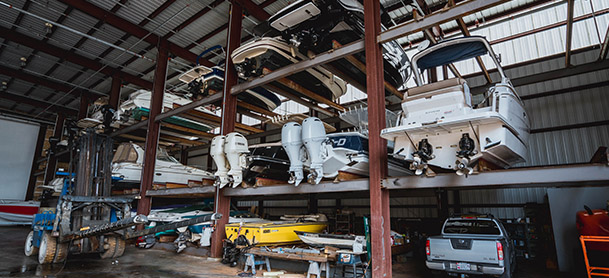
Winterization
- Winterize Your Boat

Spring Recommissioning
- Recommission Your Boat

Customer Care & Extended Protection
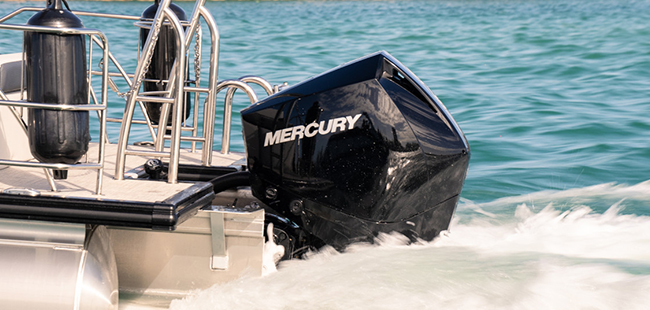
- Repower Your Engine
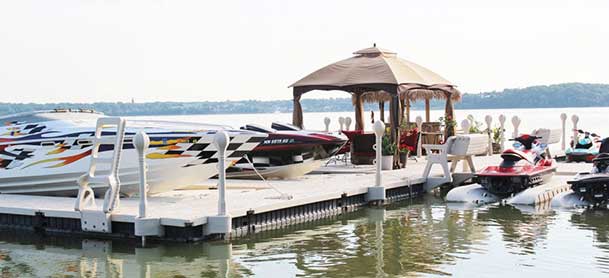
Boats Docks & Lifts
- View Docks and Lifts
You May Also Like

Boat Trade-In Evaluation

MarineMax Customer Care and Protection
MarineMax offers excellent customer care programs to protect your vessel for years to come. Explore extended warranty programs and scheduled maintenance for your marine engine.

MarineMax Financing
Let our experts provide you with short-term and long-term, hassle-free financing packages to help you fund your boating dream.

MarineMax Boat Insurance
MarineMax is here to help navigate you to the right coverage options for your boat. Protect your investment with premium, competitively priced insurance options. Find out what coverage option fits your vessel.
Closer Store Found
Based on your zipcode, [NewStoreName] should be your MarineMax store. We will update your store.
Before you Go...

IMAGES
VIDEO
COMMENTS
Check electrical connections, deck and spreader lights. Wax mast tracks and luff grooves with candle wax or Teflon spray. Standing rigging: Look for areas of wear or stranding on the wire. Check mast tangs, T-ball joints and rigging screws. Wash furling drum and swivel and check they move freely.
Refer to the chart to check maintenance items before every outing and at every 20, 50, and 100 hours of use. Seasonal boaters should consult the chart before every layup. With our chart as your guide, your rig will stay like new for longer and command top price at resale or trade-in time, particularly if you keep records of what you've done and ...
YACHT MAINTENANCE SCHEDULE For most yachts 40 feet and larger, the yacht will sit in the water full time. Regular care and maintenance is especially important in this scenario. For boaters in the Gulf of Mexico, the Gulf's waters have high levels of salinity which makes the water especially corrosive. For saltwater boaters, staying on top of ...
Following a boat maintenance schedule is key to keeping your boat in top shape. One of the most important tasks is changing and replacing the engine oil every 50-100 hours of operation. This ensures that your engine performs at its best and reduces the risk of damage. Owners should also regularly check hoses for wear and tear, as well as ensure ...
4. 100 hours of use. 5. End of season care. Here is a good example of what your boat maintenance schedule should look like: You can tell that boat maintenance is a lofty task (or set of tasks). Many owners utilize a boat maintenance log software to track all the various components and timelines in one place.
Regular maintenance will help ensure peace of mind while operating and the safety of your guests onboard. Routine maintenance on a yacht includes system checks, safety equipment inspections, and regular oil changes to ensure your vessel is functioning to its best potential. To start, you can create a maintenance schedule for your yacht by ...
The complexity of maintenance largely depends on the size, type, and age of the yacht. Modern Yachts come Equipped with Sophisticated Systems and Technology, which can add to the maintenance workload. However, with a well-structured maintenance schedule and a proactive approach, the process becomes manageable.
Replace any frayed cables. Make sure the steering system is functioning properly, grease if needed. Check the condition of the rudder or outboard bearings. Inspect all through-hull fittings and valves. The fittings must be secure, the valves must operate, and the hoses and clamps must be in good condition.
Replace items as needed to ensure your boat is in good working order. Check the engine and operating temperature. Check propeller for any damage. Test steering for any leaks. Check transom mount (if using an outboard) Check fuel lines for weak points or leaks. Do an oil change. Check spark plugs. Check fluid levels.
Cleaning. Diligent cleaning and protective coatings, such as waxing, will keep your yacht sparkling. If your vessel contains beautiful woodwork, regular treatment or varnish will help maintain its shine and keep it looking flawless. Maintaining a clean yacht is most manageable when performed on a schedule. Cleaning is also an efficient time to ...
Boat Maintenance Schedules. When you perform regular maintenance tasks, you ensure your boat functions at its best year-round. Creating a maintenance schedule reduces the likelihood of forgetting critical tasks. This maintenance timeline from the Boat Owners Association of the United States is a good place to start. 1. Maintenance Every Use
Regularly clean your boat's exterior to prevent mildew, erosion, and the spread of invasive species. Wash your boat after each outing to minimize buildup. A clean hull can save up to 30% on fuel. Maintaining the hull is equally important. For fiberglass hulls, wax and polish a few times a year to maintain the gel coat.
The best way to keep up with periodic maintenance is to follow the Inspection and Maintenance Schedule in your Mercury or MerCruiser® engine or drive operation and maintenance manual. Follow these schedules to avoid overlooking important maintenance items that are key to enjoying maximum reliability, safety and time on the water.
Inspect your boat's upholstery and clean it periodically to prevent mold or mildew growth. For enclosed spaces, add a dehumidifier to provide additional protection against mold. Finally, if your boat has vinyl upholstery, using a good vinyl cleaner protects it from cracking and keeps it looking like new. FREE Shipping on orders of $149 or more!
Prevention is the best cure when it comes to yacht maintenance. Schedule routine inspections and maintenance checks to identify any potential issues before they escalate into costly repairs or safety hazards. Check vital systems such as engines, electricals, plumbing, and navigation equipment regularly, and address any issues promptly to ensure ...
Check the fuel tank for rust and/or contamination. Ensure the hoses are not cracked and provide enough slack to account for vibration. Thoroughly inspect the tank, hose and fittings for evidence of leaks. Prior to winter storage, check antifreeze level and replace as necessary. Fill the tank prior to storage as per manufacturer's instruction. 2.
Having boat maintenance tips is crucial for its upkeep and ensuring its long-term safety and performance. Here are some key considerations to keep in mind when developing your maintenance schedule: Regular Inspections: Schedule routine inspections to identify any potential issues before they escalate. Inspect the hull, propellers, and other ...
By following a maintenance schedule, yacht owners can keep their boats in the best condition possible and address any issues before they become major problems. Maintaining the schedule using a calendar or reminder app will ensure owners do not forget to attend to the necessary schedule, with automatic notifications serving as timely reminders. ...
Streamline Your Maintenance. With PlanM8, effortlessly schedule all your vessel's maintenance tasks—standard, recommended, or manufacturer-specific. Stay ahead with our pre-generated templates, ensuring you never overlook a component. Pre-order spares easily for yachts of any size, sail or power. Simplify planning, save time.
Protection and Peace of Mind. Yamaha wants you to have an outstanding ownership experience. Maintenance plays a big part in that. We've learned a lot about caring for boats during our many years as a jet boat manufacturer, so download our complete Maintenance Matters guide and continue on for some knowledge and simple tips. Download Guide.
Monthly boat maintenance checklist. Wash the exterior: Scrubbing your boat will keep salt and dirt at bay and extend your gel coat. Clean the interior: Clean your boat's interior by wiping down surfaces and scrubbing the head. Check the bilges: Give bilges regularly ensure they're nice and dry. Run the engines: If you haven't ran your ...
Autopilot. Your boat is your escape, your sanctuary, your joy. Let MaintenanceROS be your partner in keeping it that way. With our personalized maintenance scheduling, we'll track your equipment and notify you of upcoming tasks, so you can focus on enjoying the water. Leave the details to us and experience worry-free boating like never before.
With the click of a button, you can easily connect with us and order services online for your boat - from routine maintenance, to requesting a wash or fuel or having us complete a repair. Choose between downloading the MarineMax App for quick access on your phone or simply click the link below to request service. Request Service Online.